It's so much easier when you don't have to ditch Imposter Syndrome on your own.
Imagine having instant access to Clare Josa's coaching brilliance 24/7, to answer your questions and guide you through breakthroughs, like having a Mentor In Your Pocket™.
Ditching Imposter Syndrome has already helped thousands to change their lives.
But how often do you buy a book with the best of intentions, and then never read it, or give up as soon as you hit the bit about implementing what you've been learning?
Imagine being able to bring your book to life, with:
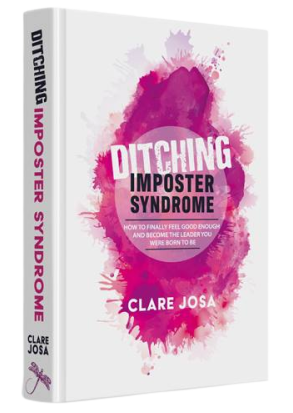
All of this is waiting for you in the Ditching Imposter Syndrome Activator™.
But that's not all: you get Clare Josa as your guide.
Meet: AskClare.ai™
Trained on 2.7 million of Clare Josa's words.
With the Ditching Imposter Syndrome Activator™ you get Mentor In Your Pocket™ access to AskClare.ai™.
Wherever you are in your journey, it's there to give you expert coaching and personalised suggestions to unblock breakthroughs, right when you need it most. Whether it's your mind telling you drama stories at 3am, or that two minutes before you need to share your disruptive idea in a meeting, AskClare.ai™ is there to help, with proven, practical guidance, not platitudes.
AskClare.ai™ transforms the way we tackle Imposter Syndrome - forever.
Imagine having a world class Imposter Syndrome Mentor on speed-dial, 24/7, to give you personalised suggestions on how to handle everything from calming your nerves before a board-room pitch, through to practical suggestions for giving tricky feedback to a team member who's wobbling.
And imagine knowing that this advice isn't just a ChatGPT regurgitation of coaching industry coping strategies and internet-scraped dodgy advice.
It's grounded in 20+ years of research, with proven, actionable strategies, backed by science, with quick-links to additional how-to resources.
It's about no longer having to struggle through those self-sabotage moments on your own.
You have on-demand, in-the-moment, expert support, 24/7.
Here are some real-world questions people have asked AskClare.ai™ - and how it guided them.
Questions they asked about help for themselves:
Here are the screenshots of this interaction. The numbers are links to resources and references, for people who want to dive right in and take more action.

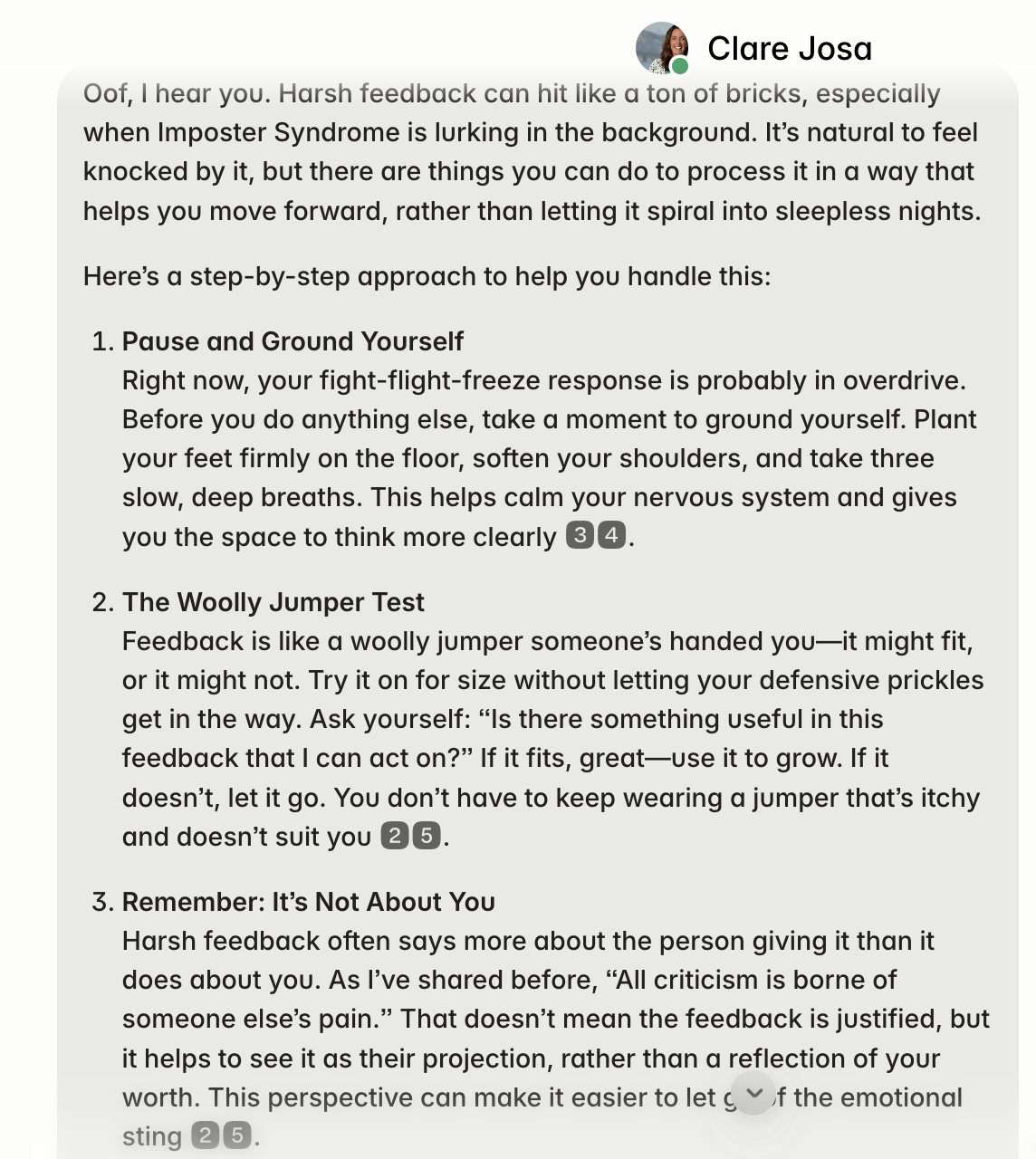
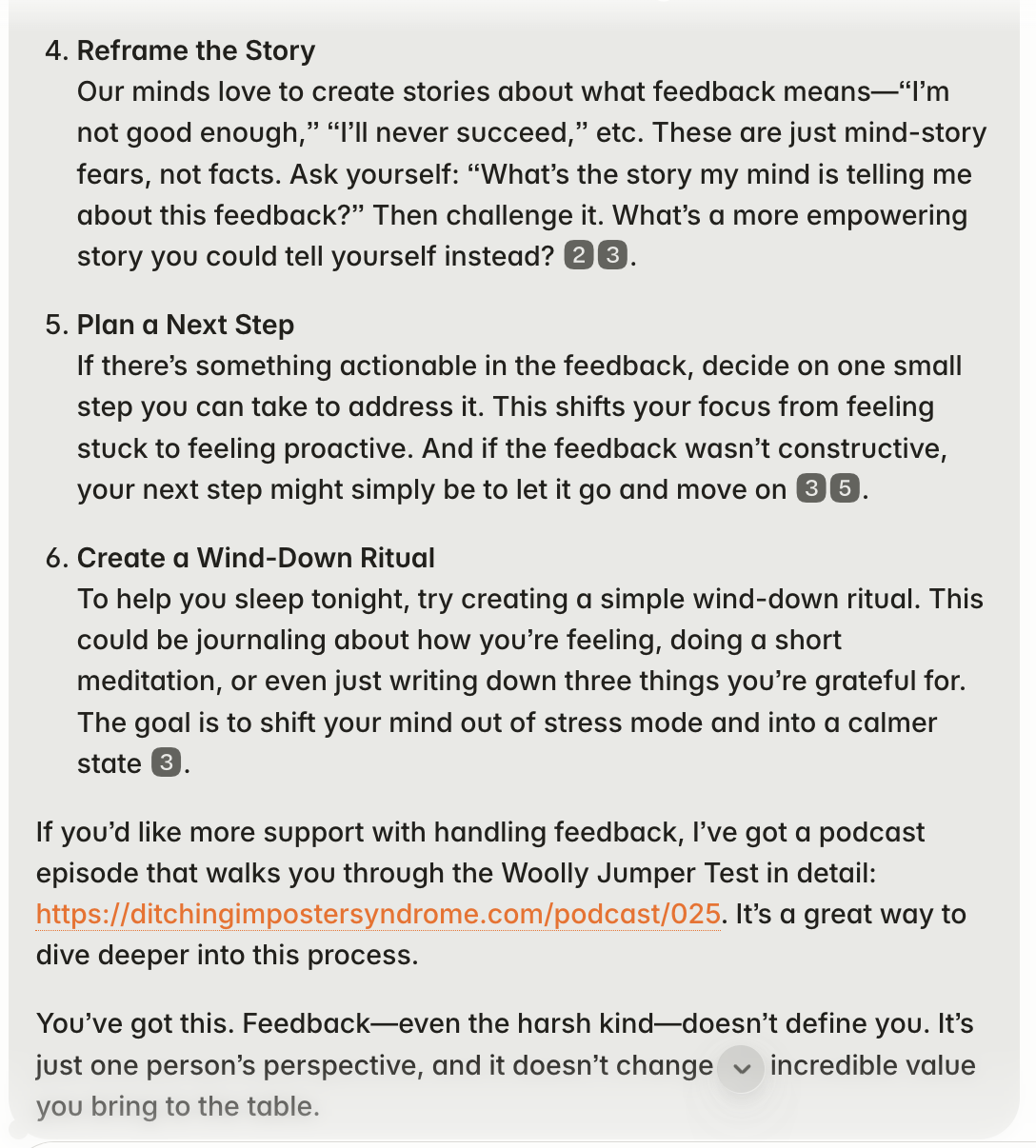

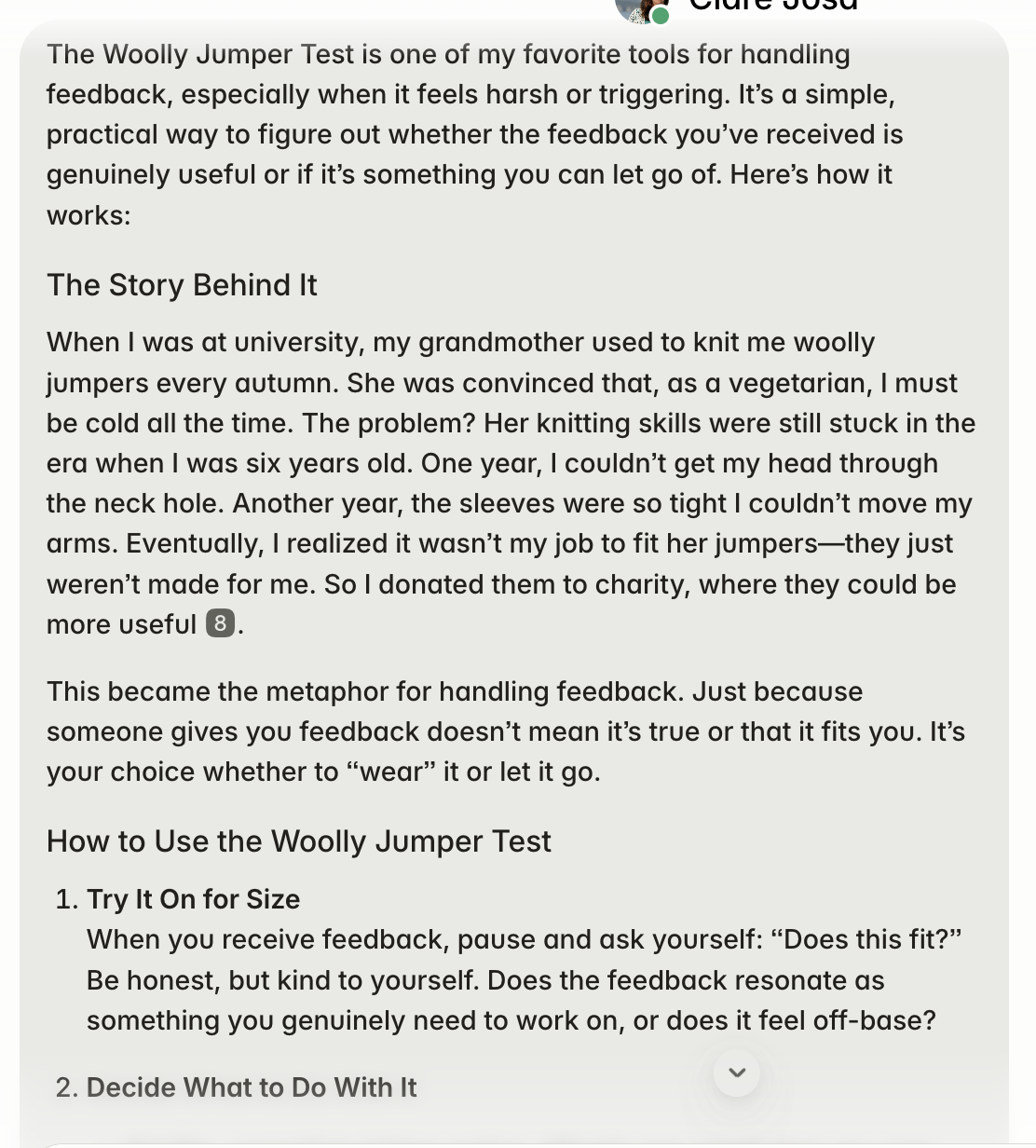
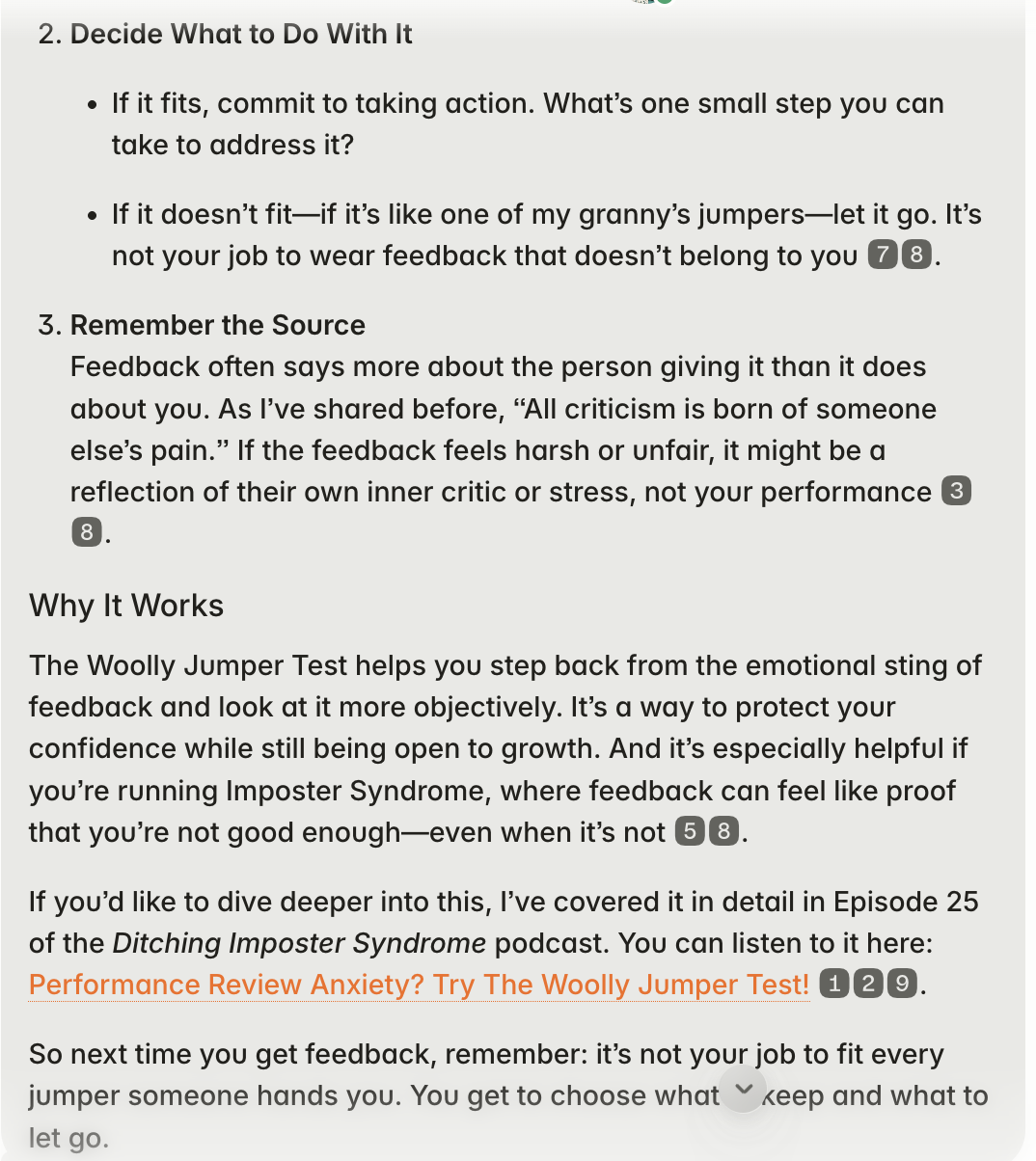
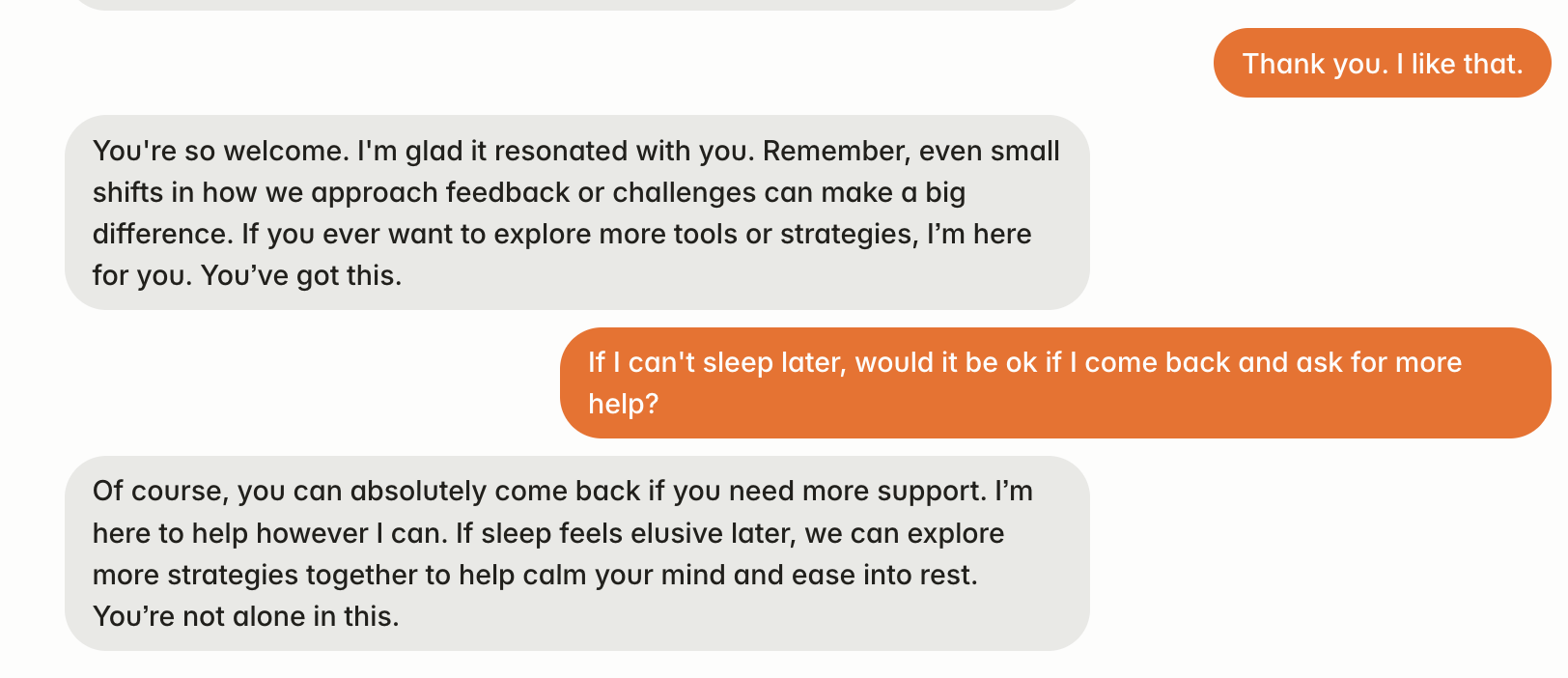
Here are the screenshots of this interaction. The numbers are links to resources and references, for people who want to dive right in and take more action.

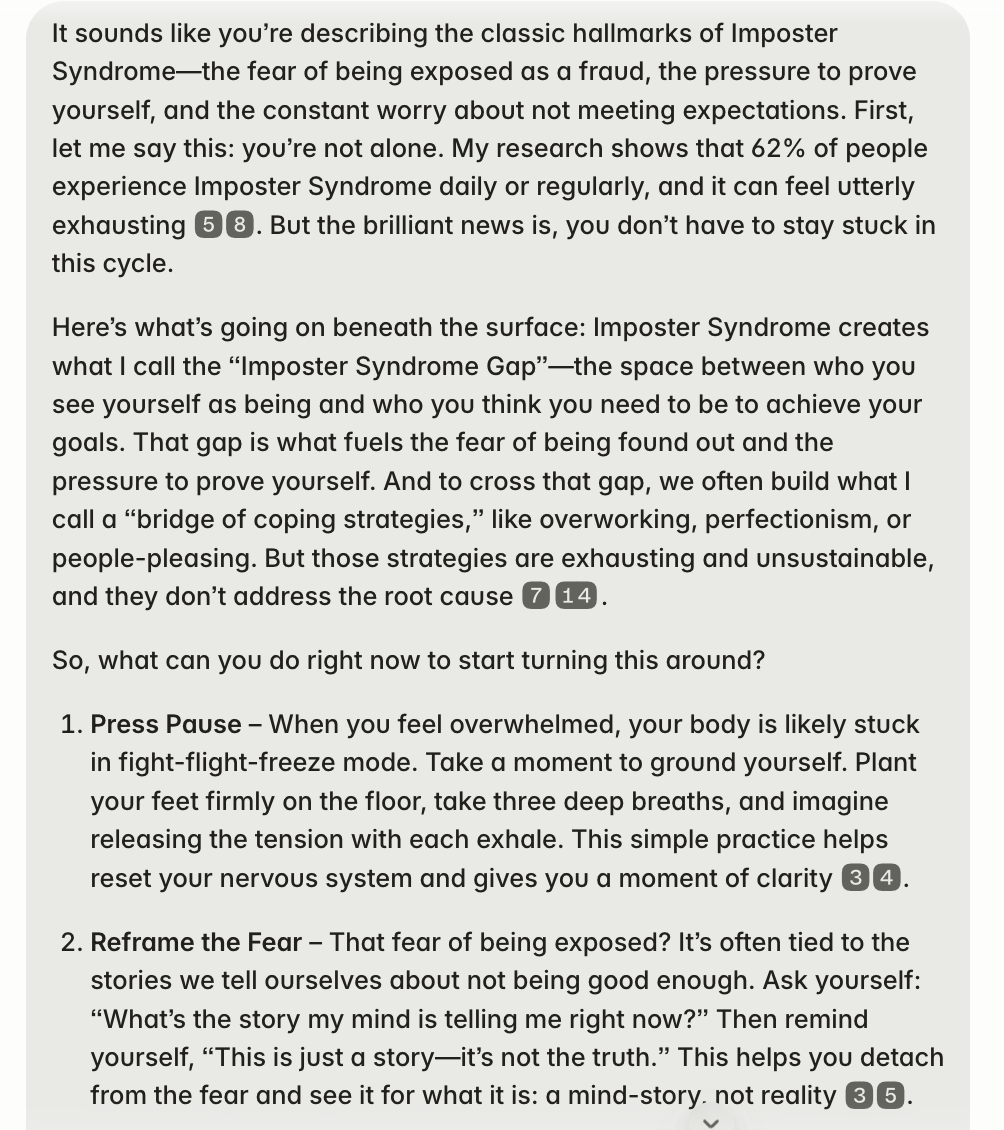
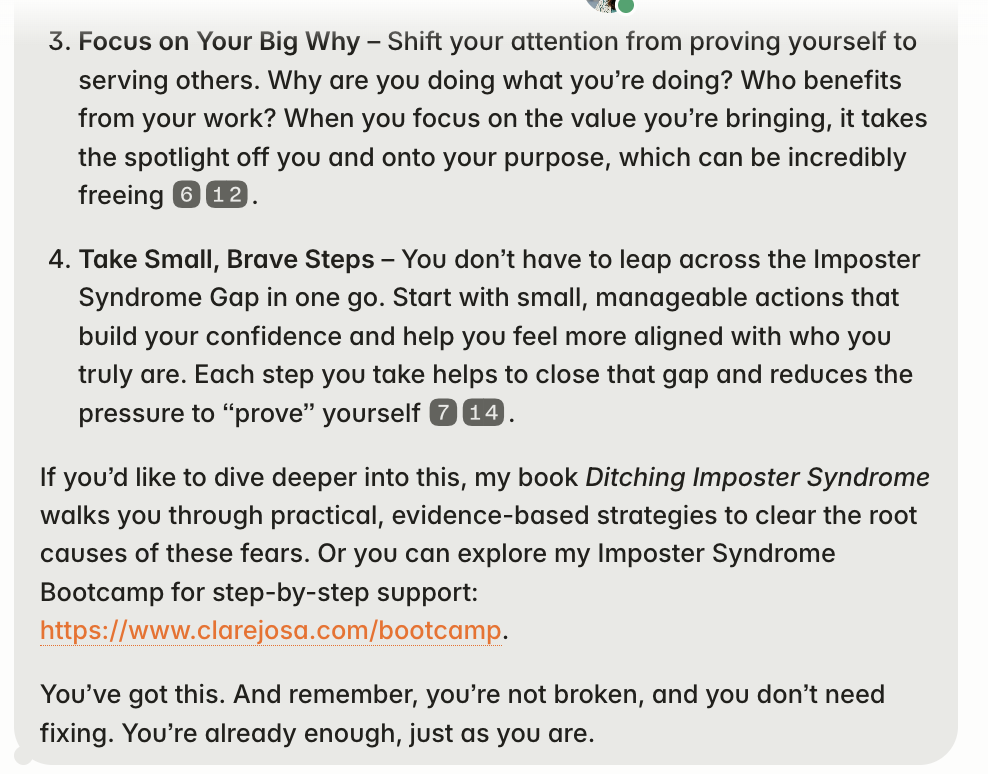

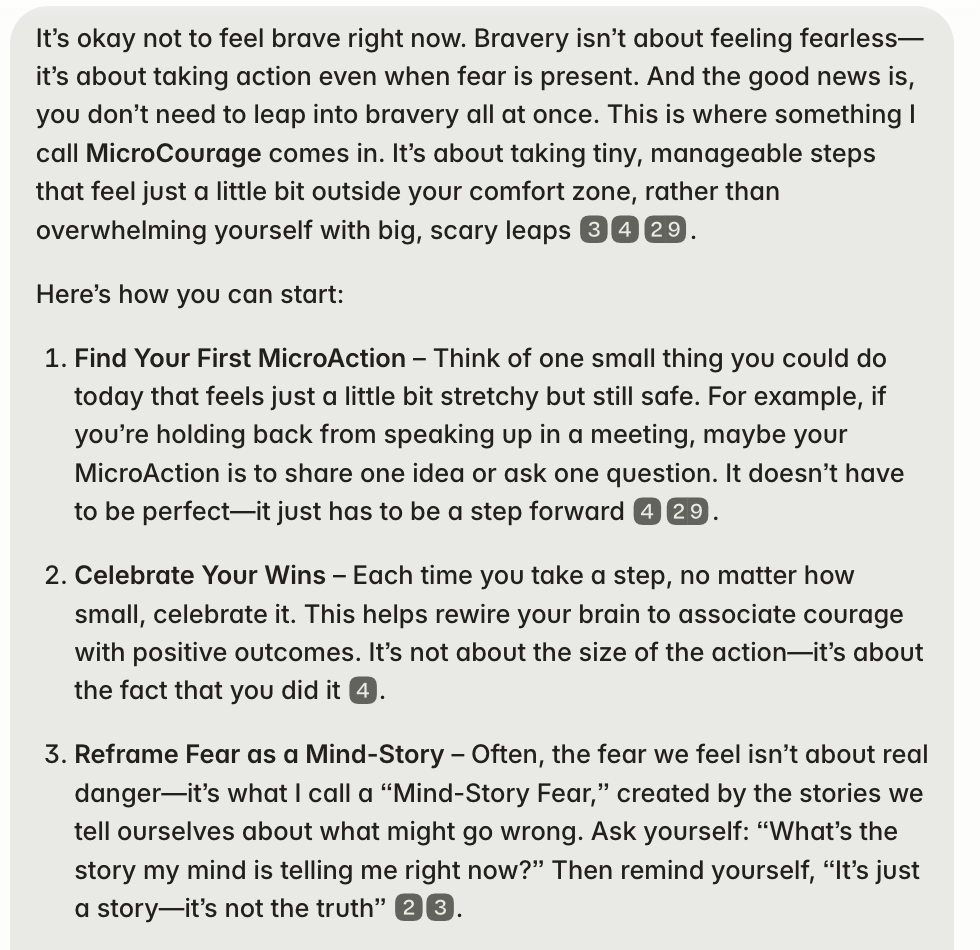
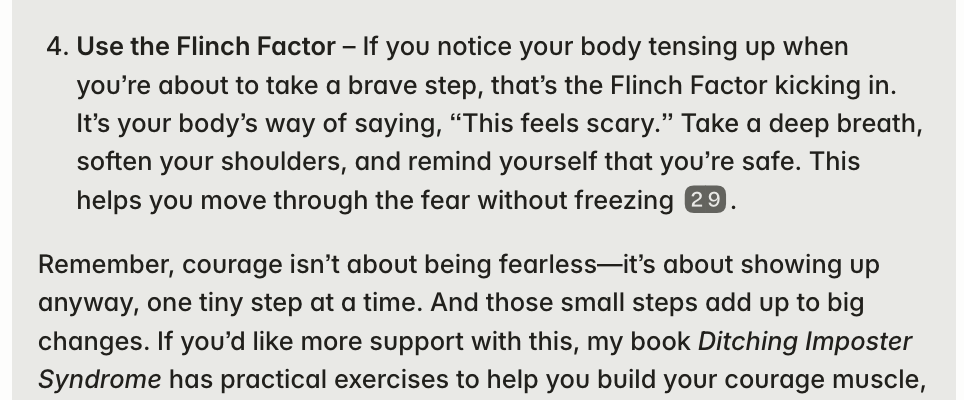
Here are the screenshots of this interaction. The numbers are links to resources and references, for people who want to dive right in and take more action.
![It’s okay not to feel brave right now. Bravery isn’t about feeling fearless—it’s about taking action even when fear is present. And the good news is, you don’t need to leap into bravery all at once. This is where something I call **MicroCourage** comes in. It’s about taking tiny, manageable steps that feel just a little bit outside your comfort zone, rather than overwhelming yourself with big, scary leaps [3][4][29]. Here’s how you can start: 1. **Find Your First MicroAction** – Think of one small thing you could do today that feels just a little bit stretchy but still safe. For example, if you’re holding back from speaking up in a meeting, maybe your MicroAction is to share one idea or ask one question. It doesn’t have to be perfect—it just has to be a step forward [4][29]. 2. **Celebrate Your Wins** – Each time you take a step, no matter how small, celebrate it. This helps rewire your brain to associate courage with positive outcomes. It’s not about the size of the action—it’s about the fact that you did it [4]. 3. **Reframe Fear as a Mind-Story** – Often, the fear we feel isn’t about real danger—it’s what I call a “Mind-Story Fear,” created by the stories we tell ourselves about what might go wrong. Ask yourself: “What’s the story my mind is telling me right now?” Then remind yourself, “It’s just a story—it’s not the truth” [2][3]. 4. **Use the Flinch Factor** – If you notice your body tensing up when you’re about to take a brave step, that’s the Flinch Factor kicking in. It’s your body’s way of saying, “This feels scary.” Take a deep breath, soften your shoulders, and remind yourself that you’re safe. This helps you move through the fear without freezing [29]. Remember, courage isn’t about being fearless—it’s about showing up anyway, one tiny step at a time. And those small steps add up to big changes. If you’d like more support with this, my book *Ditching Imposter Syndrome* has practical exercises to help you build your courage muscle, or you can explore the Sixty-Second Courage Creator training inside the Imposter Syndrome Hacks™ App - https://www.impostersyndromehacks.com. You’ve got this.](https://ditchingimpostersyndrome.com/wp-content/uploads/2025/04/Screenshot-2025-04-25-at-15.14.57.png)
![It’s okay not to feel brave right now. Bravery isn’t about feeling fearless—it’s about taking action even when fear is present. And the good news is, you don’t need to leap into bravery all at once. This is where something I call **MicroCourage** comes in. It’s about taking tiny, manageable steps that feel just a little bit outside your comfort zone, rather than overwhelming yourself with big, scary leaps [3][4][29]. Here’s how you can start: 1. **Find Your First MicroAction** – Think of one small thing you could do today that feels just a little bit stretchy but still safe. For example, if you’re holding back from speaking up in a meeting, maybe your MicroAction is to share one idea or ask one question. It doesn’t have to be perfect—it just has to be a step forward [4][29]. 2. **Celebrate Your Wins** – Each time you take a step, no matter how small, celebrate it. This helps rewire your brain to associate courage with positive outcomes. It’s not about the size of the action—it’s about the fact that you did it [4]. 3. **Reframe Fear as a Mind-Story** – Often, the fear we feel isn’t about real danger—it’s what I call a “Mind-Story Fear,” created by the stories we tell ourselves about what might go wrong. Ask yourself: “What’s the story my mind is telling me right now?” Then remind yourself, “It’s just a story—it’s not the truth” [2][3]. 4. **Use the Flinch Factor** – If you notice your body tensing up when you’re about to take a brave step, that’s the Flinch Factor kicking in. It’s your body’s way of saying, “This feels scary.” Take a deep breath, soften your shoulders, and remind yourself that you’re safe. This helps you move through the fear without freezing [29]. Remember, courage isn’t about being fearless—it’s about showing up anyway, one tiny step at a time. And those small steps add up to big changes. If you’d like more support with this, my book *Ditching Imposter Syndrome* has practical exercises to help you build your courage muscle, or you can explore the Sixty-Second Courage Creator training inside the Imposter Syndrome Hacks™ App - https://www.impostersyndromehacks.com. You’ve got this.](https://ditchingimpostersyndrome.com/wp-content/uploads/2025/04/Screenshot-2025-04-25-at-15.15.05.png)
![It’s okay not to feel brave right now. Bravery isn’t about feeling fearless—it’s about taking action even when fear is present. And the good news is, you don’t need to leap into bravery all at once. This is where something I call **MicroCourage** comes in. It’s about taking tiny, manageable steps that feel just a little bit outside your comfort zone, rather than overwhelming yourself with big, scary leaps [3][4][29]. Here’s how you can start: 1. **Find Your First MicroAction** – Think of one small thing you could do today that feels just a little bit stretchy but still safe. For example, if you’re holding back from speaking up in a meeting, maybe your MicroAction is to share one idea or ask one question. It doesn’t have to be perfect—it just has to be a step forward [4][29]. 2. **Celebrate Your Wins** – Each time you take a step, no matter how small, celebrate it. This helps rewire your brain to associate courage with positive outcomes. It’s not about the size of the action—it’s about the fact that you did it [4]. 3. **Reframe Fear as a Mind-Story** – Often, the fear we feel isn’t about real danger—it’s what I call a “Mind-Story Fear,” created by the stories we tell ourselves about what might go wrong. Ask yourself: “What’s the story my mind is telling me right now?” Then remind yourself, “It’s just a story—it’s not the truth” [2][3]. 4. **Use the Flinch Factor** – If you notice your body tensing up when you’re about to take a brave step, that’s the Flinch Factor kicking in. It’s your body’s way of saying, “This feels scary.” Take a deep breath, soften your shoulders, and remind yourself that you’re safe. This helps you move through the fear without freezing [29]. Remember, courage isn’t about being fearless—it’s about showing up anyway, one tiny step at a time. And those small steps add up to big changes. If you’d like more support with this, my book *Ditching Imposter Syndrome* has practical exercises to help you build your courage muscle, or you can explore the Sixty-Second Courage Creator training inside the Imposter Syndrome Hacks™ App - https://www.impostersyndromehacks.com. You’ve got this.](https://ditchingimpostersyndrome.com/wp-content/uploads/2025/04/Screenshot-2025-04-25-at-15.15.13.png)
Here are the screenshots of this interaction. The numbers are links to resources and references, for people who want to dive right in and take more action.
![It’s okay not to feel brave right now. Bravery isn’t about feeling fearless—it’s about taking action even when fear is present. And the good news is, you don’t need to leap into bravery all at once. This is where something I call **MicroCourage** comes in. It’s about taking tiny, manageable steps that feel just a little bit outside your comfort zone, rather than overwhelming yourself with big, scary leaps [3][4][29]. Here’s how you can start: 1. **Find Your First MicroAction** – Think of one small thing you could do today that feels just a little bit stretchy but still safe. For example, if you’re holding back from speaking up in a meeting, maybe your MicroAction is to share one idea or ask one question. It doesn’t have to be perfect—it just has to be a step forward [4][29]. 2. **Celebrate Your Wins** – Each time you take a step, no matter how small, celebrate it. This helps rewire your brain to associate courage with positive outcomes. It’s not about the size of the action—it’s about the fact that you did it [4]. 3. **Reframe Fear as a Mind-Story** – Often, the fear we feel isn’t about real danger—it’s what I call a “Mind-Story Fear,” created by the stories we tell ourselves about what might go wrong. Ask yourself: “What’s the story my mind is telling me right now?” Then remind yourself, “It’s just a story—it’s not the truth” [2][3]. 4. **Use the Flinch Factor** – If you notice your body tensing up when you’re about to take a brave step, that’s the Flinch Factor kicking in. It’s your body’s way of saying, “This feels scary.” Take a deep breath, soften your shoulders, and remind yourself that you’re safe. This helps you move through the fear without freezing [29]. Remember, courage isn’t about being fearless—it’s about showing up anyway, one tiny step at a time. And those small steps add up to big changes. If you’d like more support with this, my book *Ditching Imposter Syndrome* has practical exercises to help you build your courage muscle, or you can explore the Sixty-Second Courage Creator training inside the Imposter Syndrome Hacks™ App - https://www.impostersyndromehacks.com. You’ve got this.](https://ditchingimpostersyndrome.com/wp-content/uploads/2025/04/Screenshot-2025-04-25-at-15.15.26.png)
![It’s okay not to feel brave right now. Bravery isn’t about feeling fearless—it’s about taking action even when fear is present. And the good news is, you don’t need to leap into bravery all at once. This is where something I call **MicroCourage** comes in. It’s about taking tiny, manageable steps that feel just a little bit outside your comfort zone, rather than overwhelming yourself with big, scary leaps [3][4][29]. Here’s how you can start: 1. **Find Your First MicroAction** – Think of one small thing you could do today that feels just a little bit stretchy but still safe. For example, if you’re holding back from speaking up in a meeting, maybe your MicroAction is to share one idea or ask one question. It doesn’t have to be perfect—it just has to be a step forward [4][29]. 2. **Celebrate Your Wins** – Each time you take a step, no matter how small, celebrate it. This helps rewire your brain to associate courage with positive outcomes. It’s not about the size of the action—it’s about the fact that you did it [4]. 3. **Reframe Fear as a Mind-Story** – Often, the fear we feel isn’t about real danger—it’s what I call a “Mind-Story Fear,” created by the stories we tell ourselves about what might go wrong. Ask yourself: “What’s the story my mind is telling me right now?” Then remind yourself, “It’s just a story—it’s not the truth” [2][3]. 4. **Use the Flinch Factor** – If you notice your body tensing up when you’re about to take a brave step, that’s the Flinch Factor kicking in. It’s your body’s way of saying, “This feels scary.” Take a deep breath, soften your shoulders, and remind yourself that you’re safe. This helps you move through the fear without freezing [29]. Remember, courage isn’t about being fearless—it’s about showing up anyway, one tiny step at a time. And those small steps add up to big changes. If you’d like more support with this, my book *Ditching Imposter Syndrome* has practical exercises to help you build your courage muscle, or you can explore the Sixty-Second Courage Creator training inside the Imposter Syndrome Hacks™ App - https://www.impostersyndromehacks.com. You’ve got this.](https://ditchingimpostersyndrome.com/wp-content/uploads/2025/04/Screenshot-2025-04-25-at-15.15.35.png)
![It’s okay not to feel brave right now. Bravery isn’t about feeling fearless—it’s about taking action even when fear is present. And the good news is, you don’t need to leap into bravery all at once. This is where something I call **MicroCourage** comes in. It’s about taking tiny, manageable steps that feel just a little bit outside your comfort zone, rather than overwhelming yourself with big, scary leaps [3][4][29]. Here’s how you can start: 1. **Find Your First MicroAction** – Think of one small thing you could do today that feels just a little bit stretchy but still safe. For example, if you’re holding back from speaking up in a meeting, maybe your MicroAction is to share one idea or ask one question. It doesn’t have to be perfect—it just has to be a step forward [4][29]. 2. **Celebrate Your Wins** – Each time you take a step, no matter how small, celebrate it. This helps rewire your brain to associate courage with positive outcomes. It’s not about the size of the action—it’s about the fact that you did it [4]. 3. **Reframe Fear as a Mind-Story** – Often, the fear we feel isn’t about real danger—it’s what I call a “Mind-Story Fear,” created by the stories we tell ourselves about what might go wrong. Ask yourself: “What’s the story my mind is telling me right now?” Then remind yourself, “It’s just a story—it’s not the truth” [2][3]. 4. **Use the Flinch Factor** – If you notice your body tensing up when you’re about to take a brave step, that’s the Flinch Factor kicking in. It’s your body’s way of saying, “This feels scary.” Take a deep breath, soften your shoulders, and remind yourself that you’re safe. This helps you move through the fear without freezing [29]. Remember, courage isn’t about being fearless—it’s about showing up anyway, one tiny step at a time. And those small steps add up to big changes. If you’d like more support with this, my book *Ditching Imposter Syndrome* has practical exercises to help you build your courage muscle, or you can explore the Sixty-Second Courage Creator training inside the Imposter Syndrome Hacks™ App - https://www.impostersyndromehacks.com. You’ve got this.](https://ditchingimpostersyndrome.com/wp-content/uploads/2025/04/Screenshot-2025-04-25-at-15.15.43.png)
What You Get In The
Ditching Imposter Syndrome Activator™
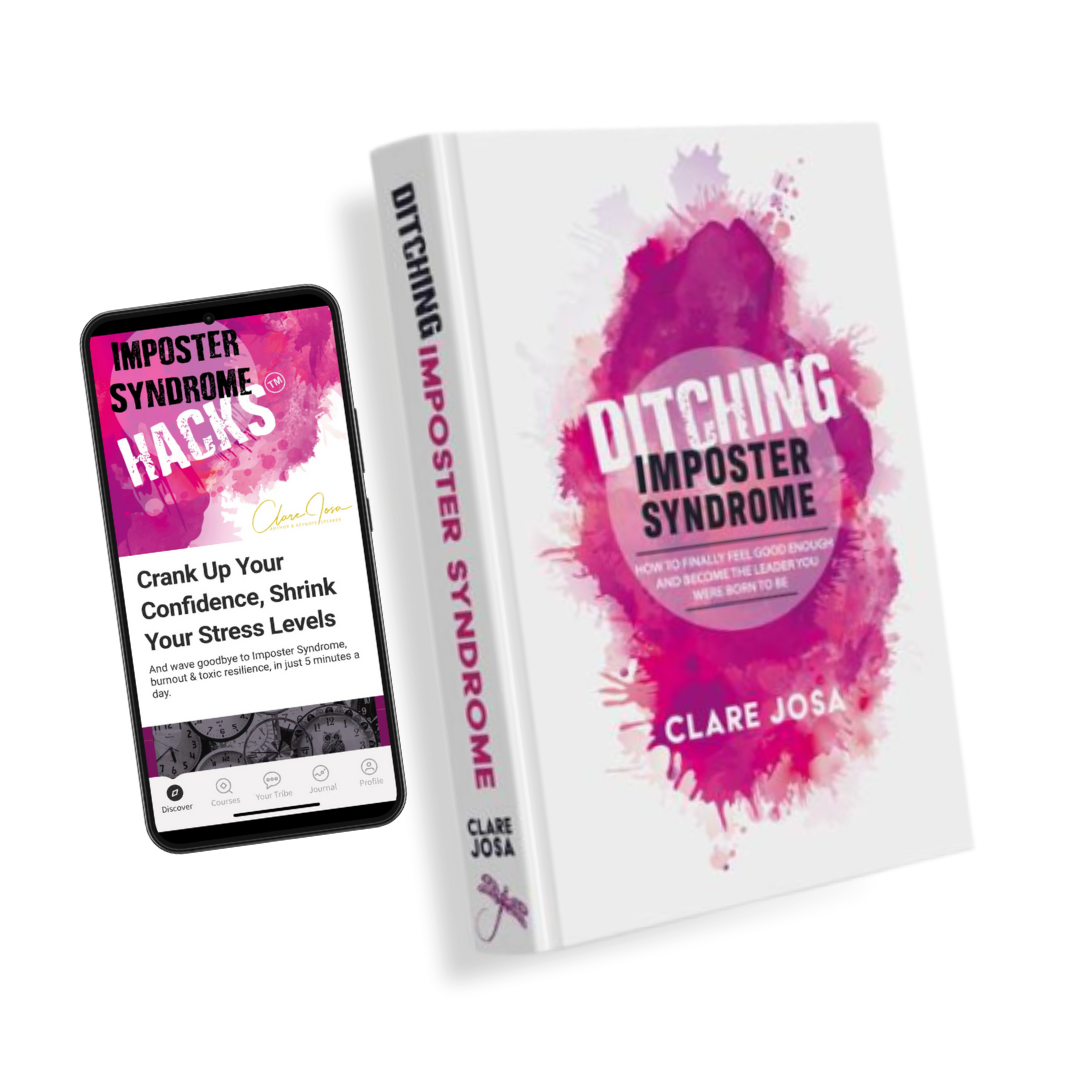
The Book
Get the eBook and the audiobook - and Clare can even send you a signed physical copy.
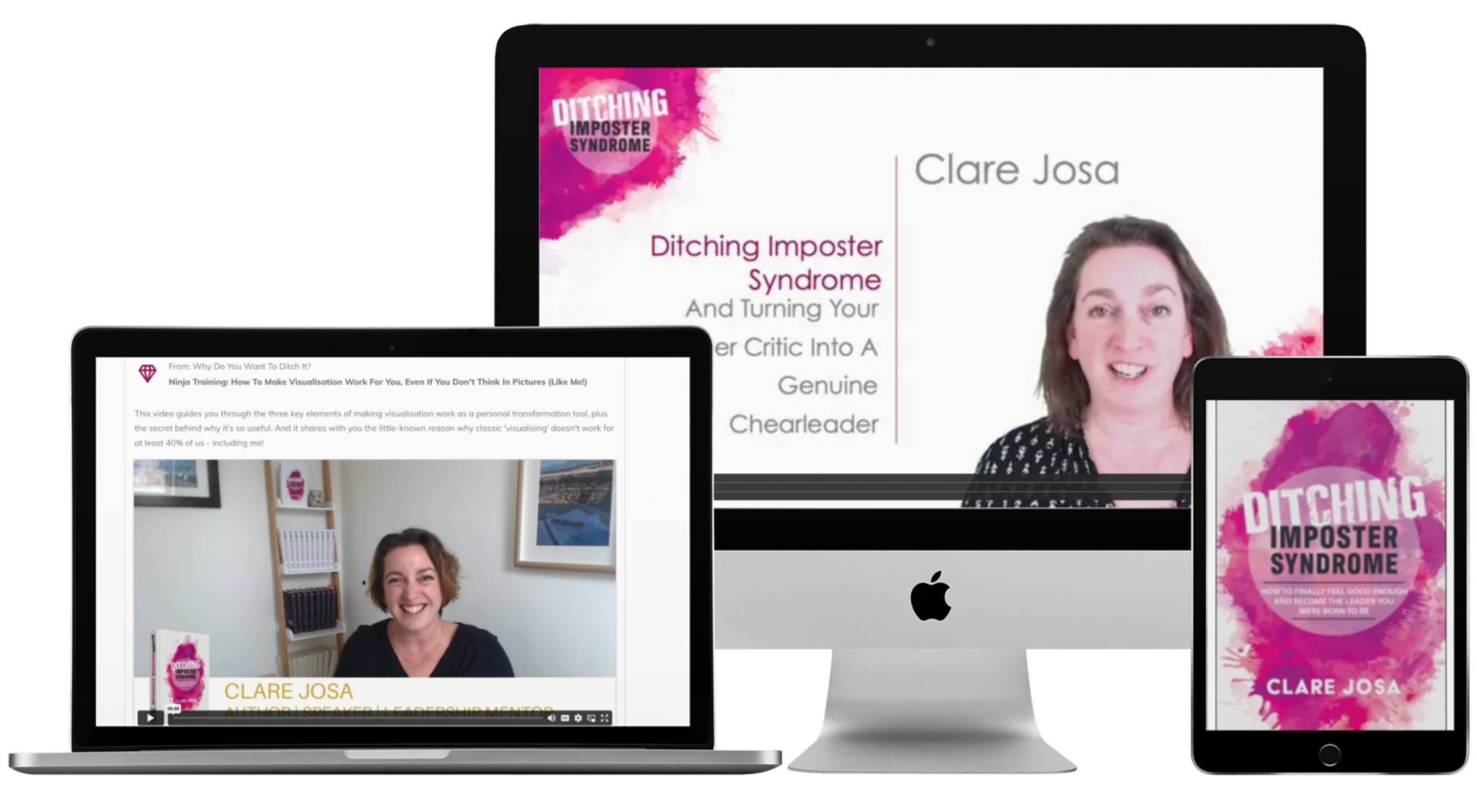
The 'Beyond the Book' Trainings
Audios to guide you through each exercise, high-impact video trainings, cheat sheets, and more.

AskClare.ai™
Your Mentor in Your Pocket™ to help you create breakthroughs, fast, in your confidence, stress levels, burnout, and Imposter Syndrome.
Here are some more real-world questions people have asked AskClare.ai™ - and how it guided them.
Questions they asked about helping others:
Here are the screenshots of this interaction. The numbers are links to resources and references, for people who want to dive right in and take more action.

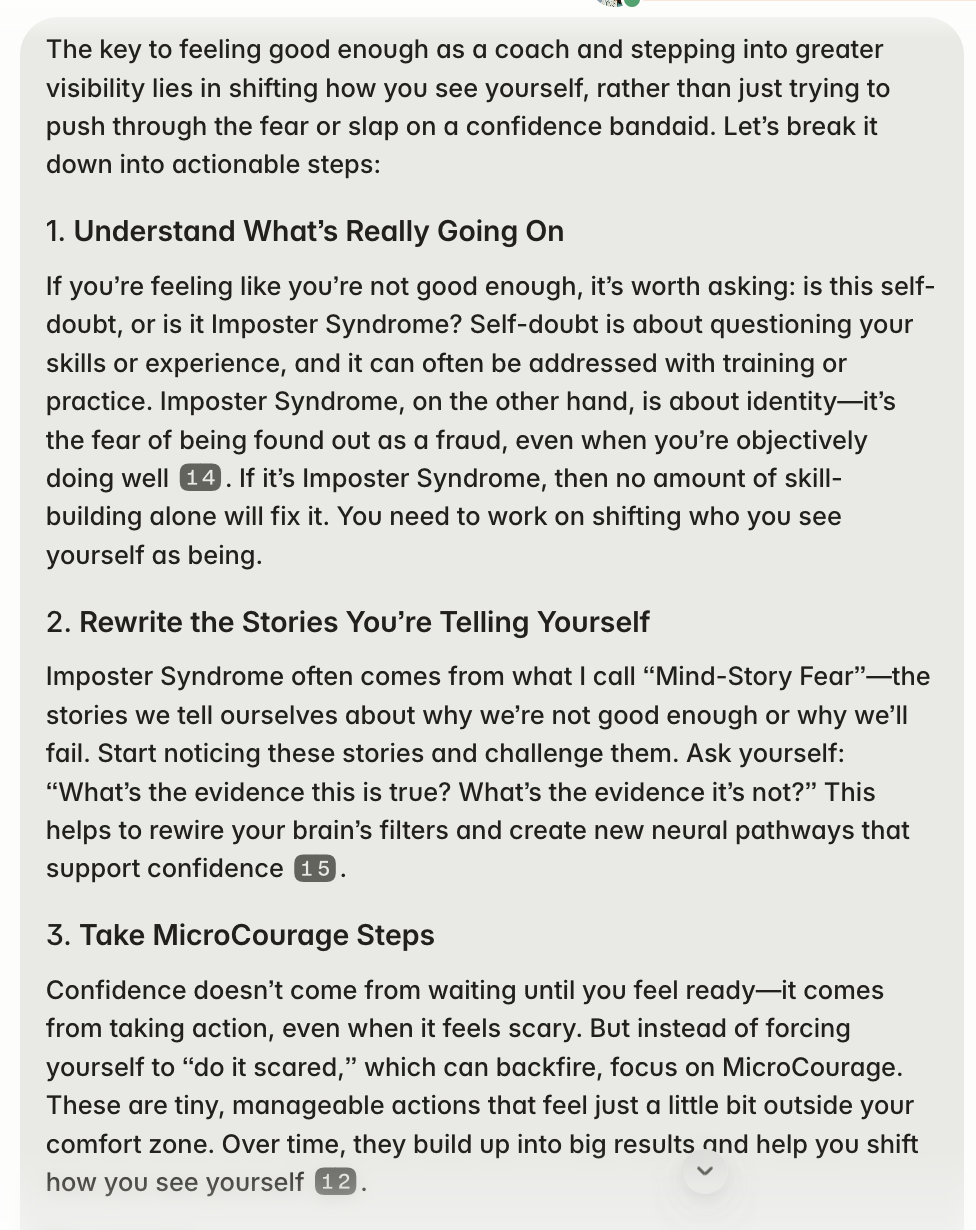
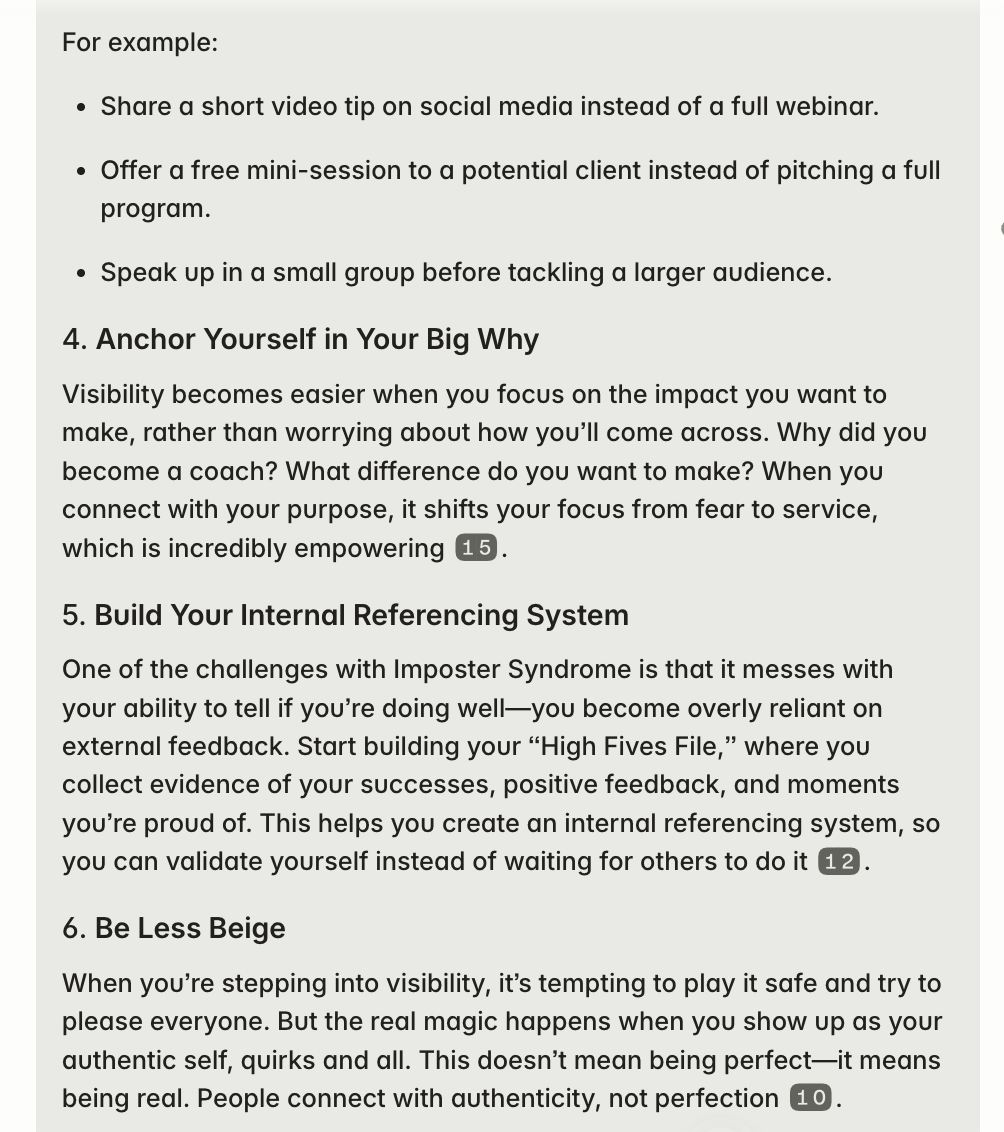
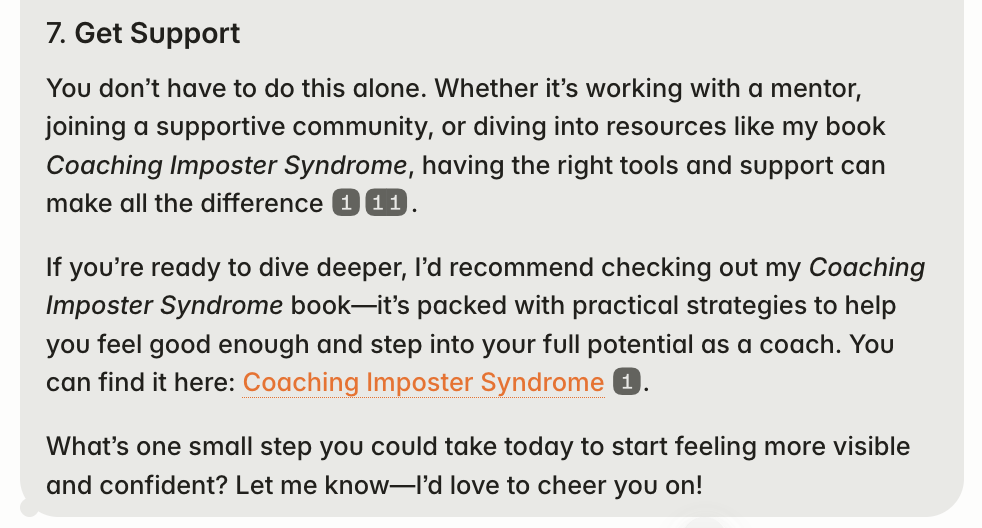
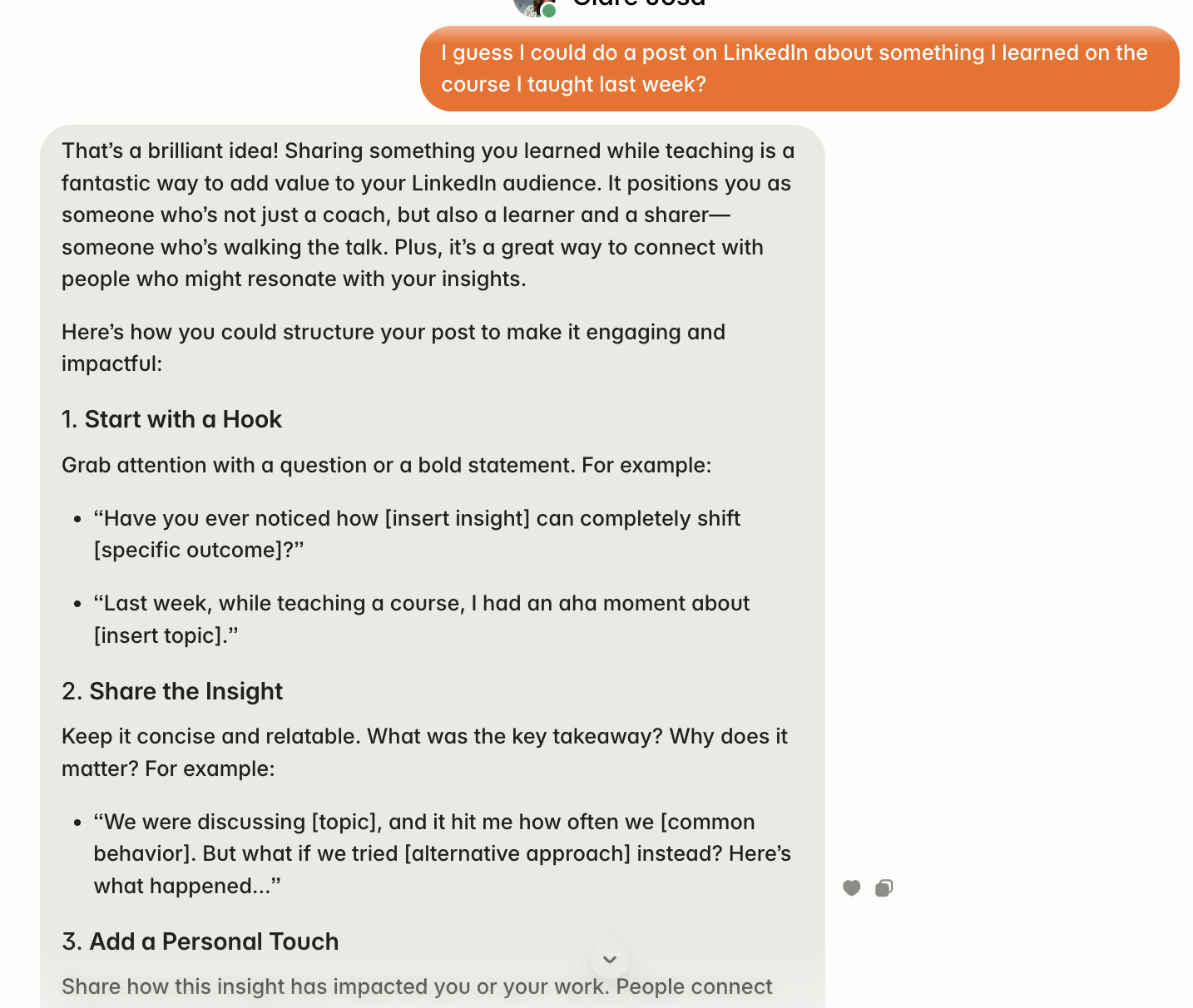
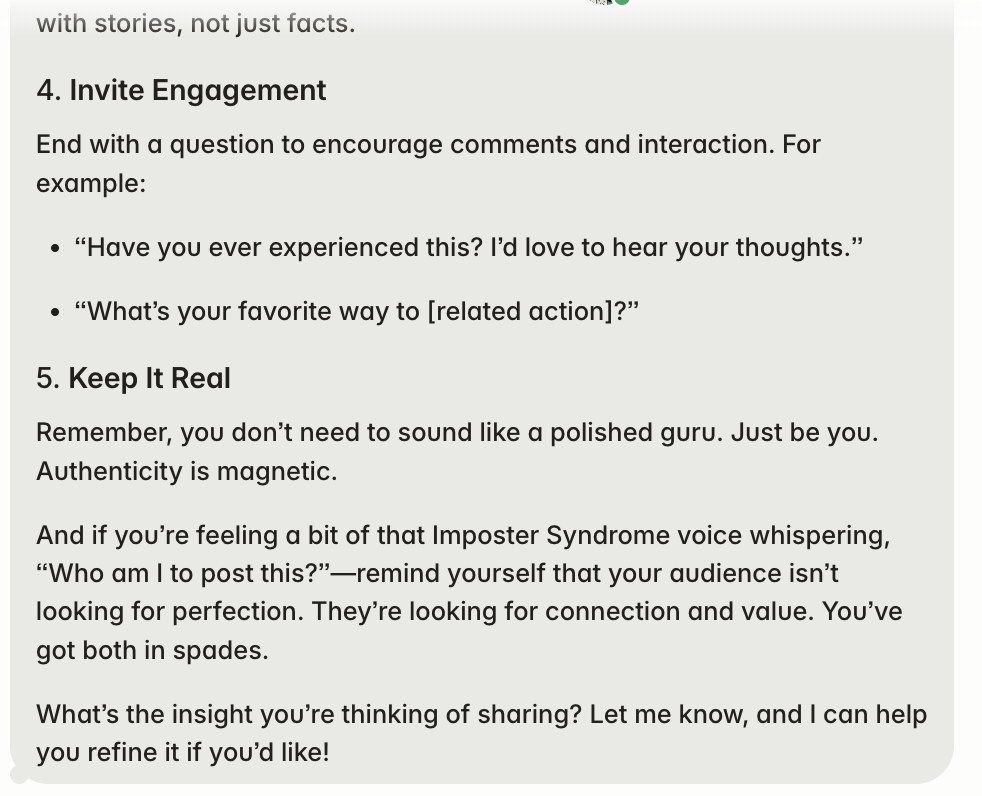
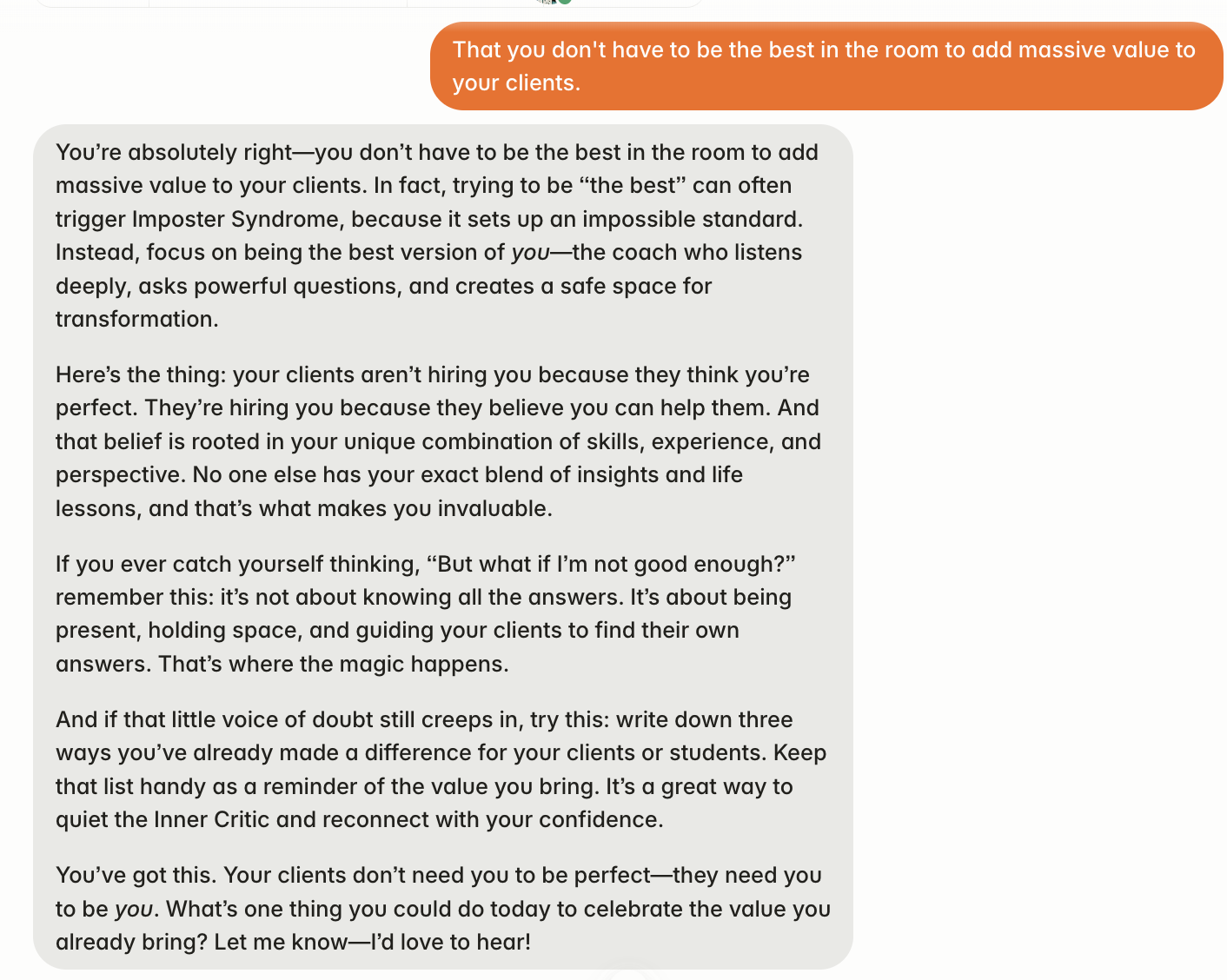
Here are the screenshots of this interaction. The numbers are links to resources and references, for people who want to dive right in and take more action.

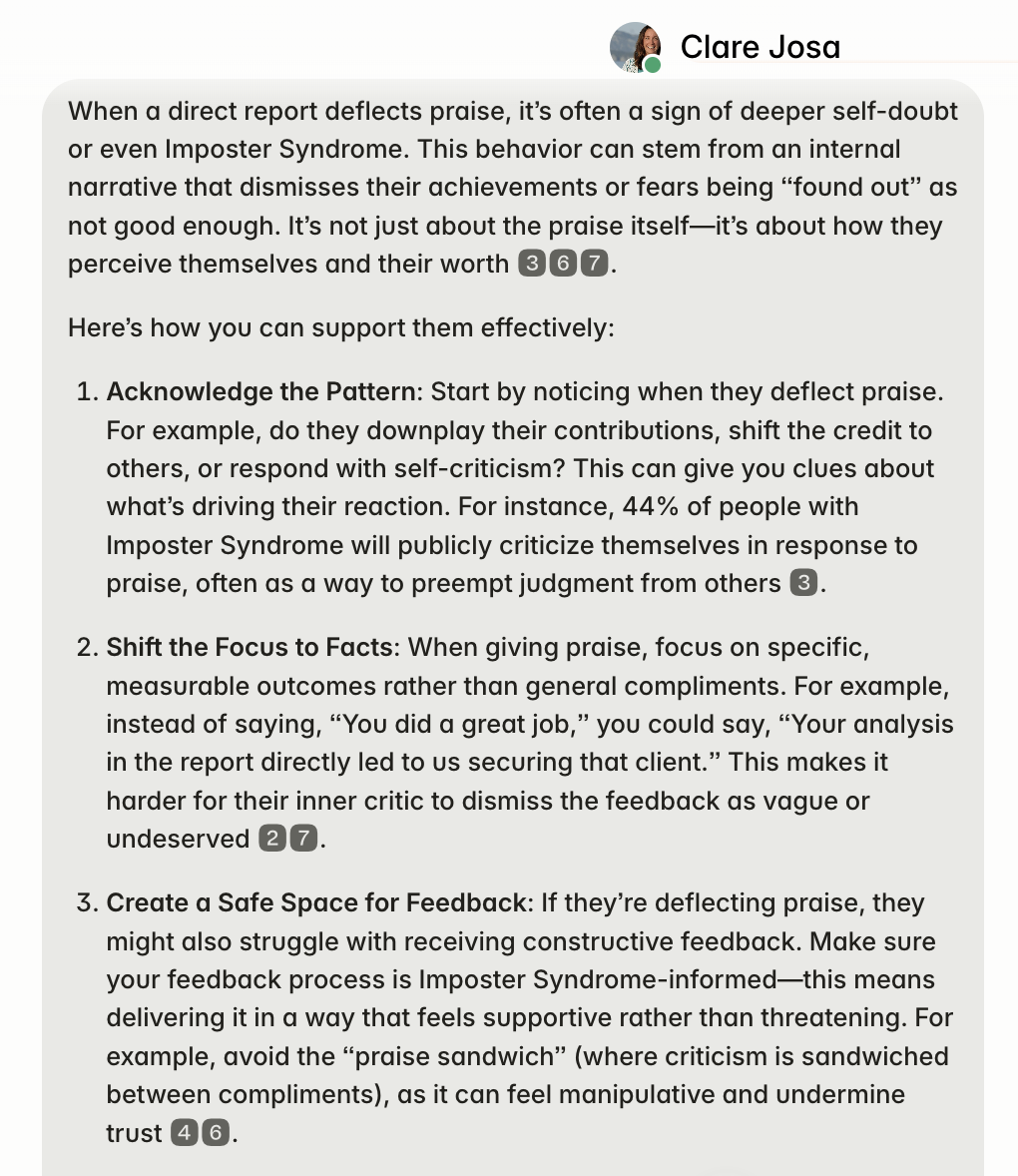
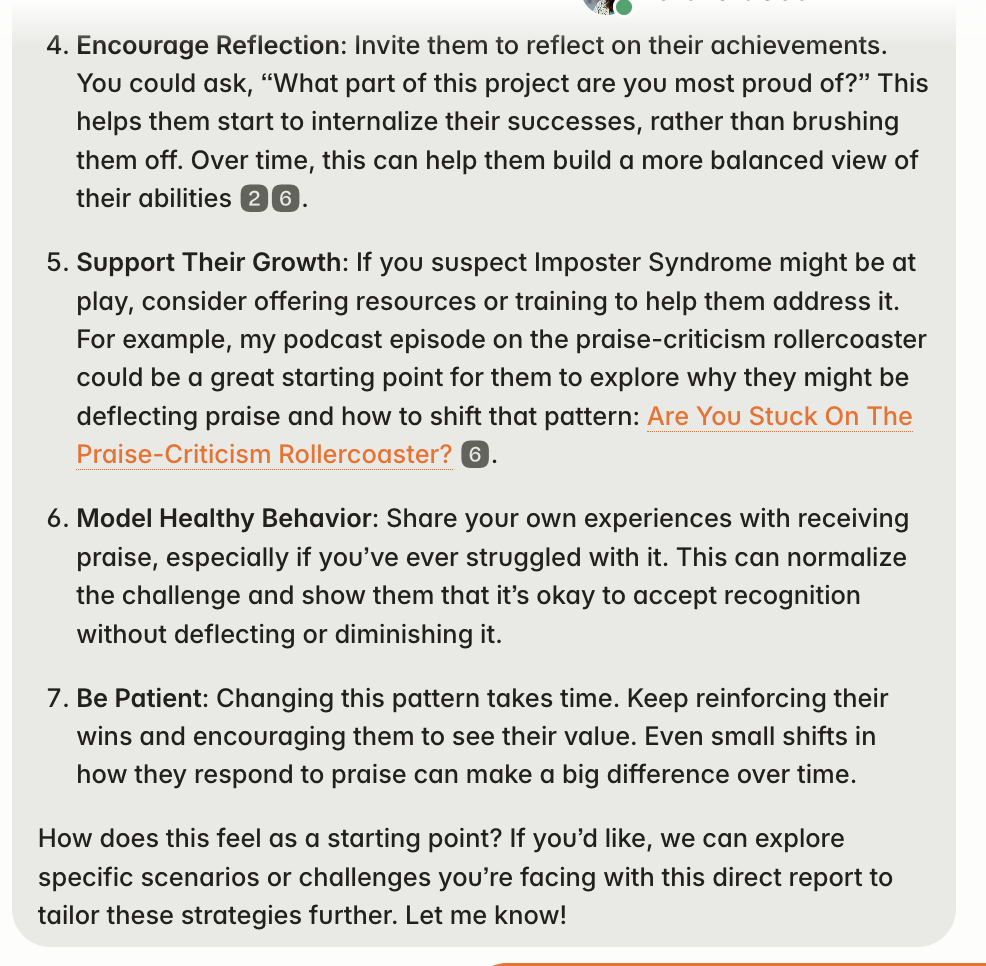

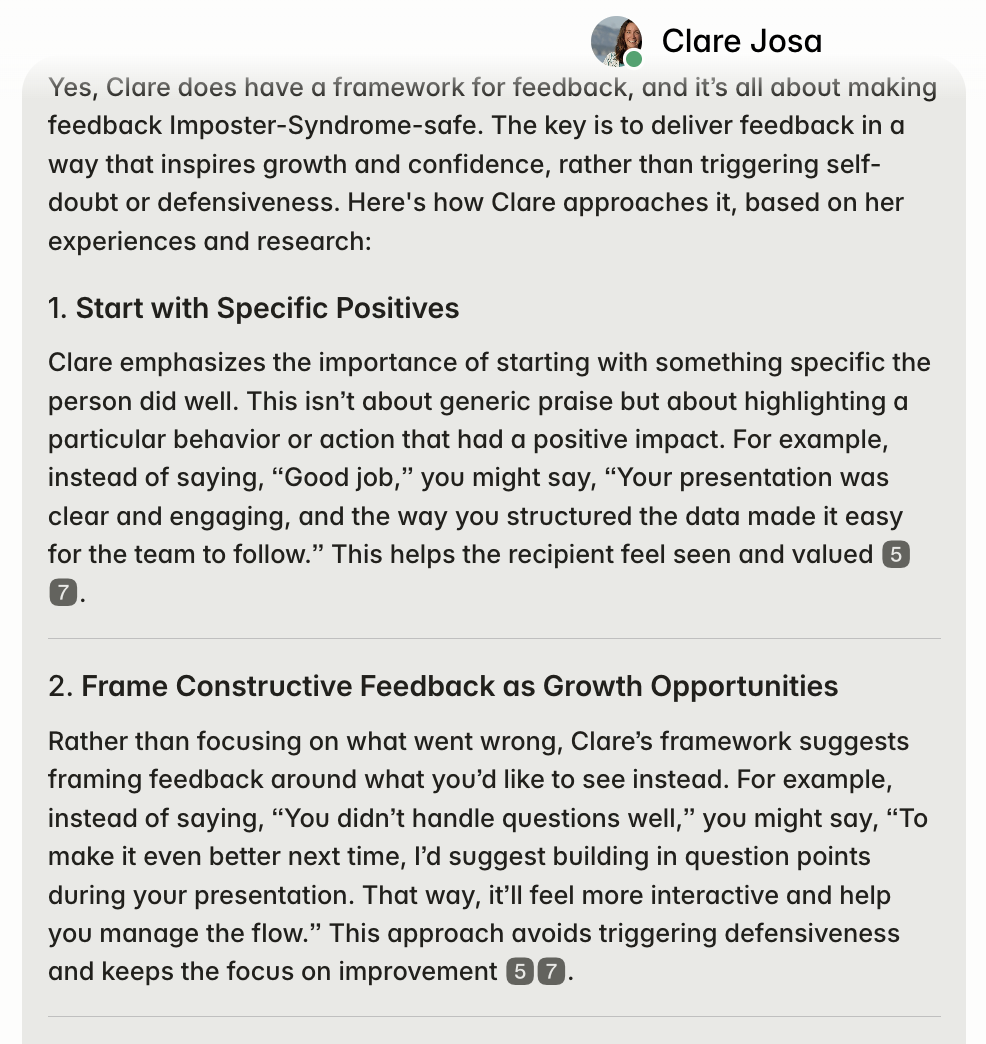
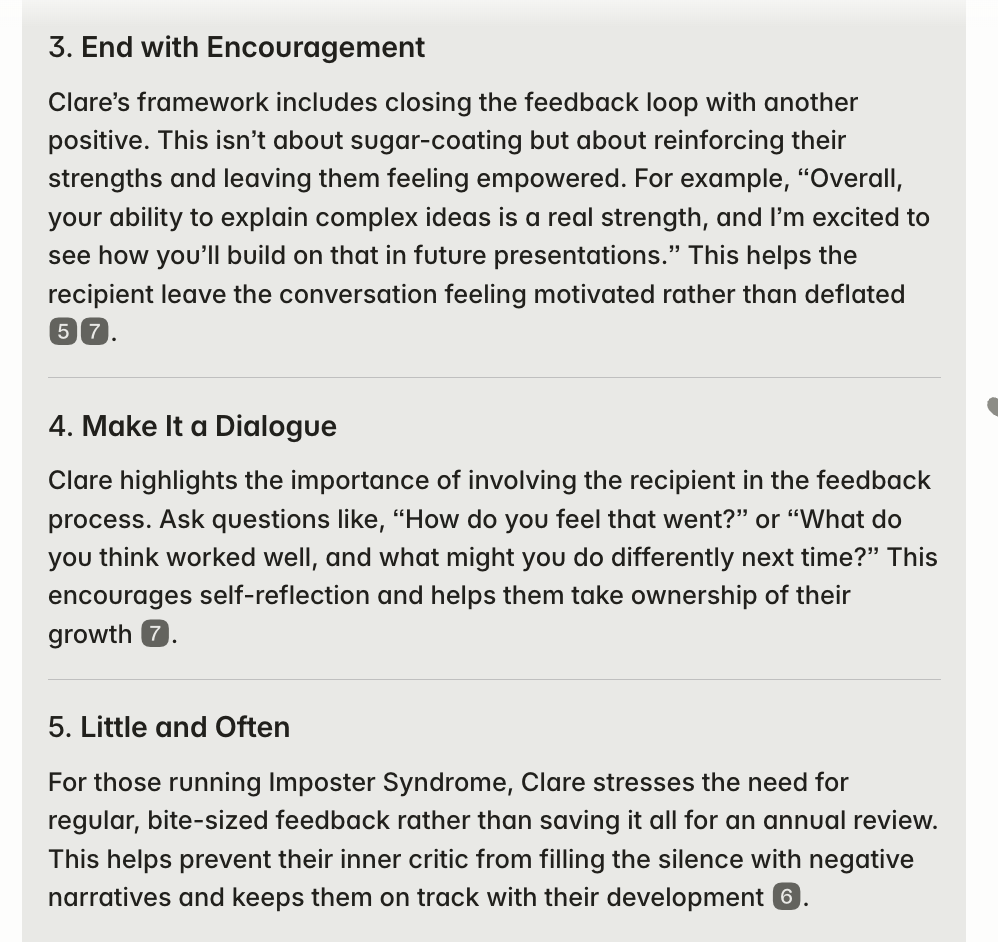
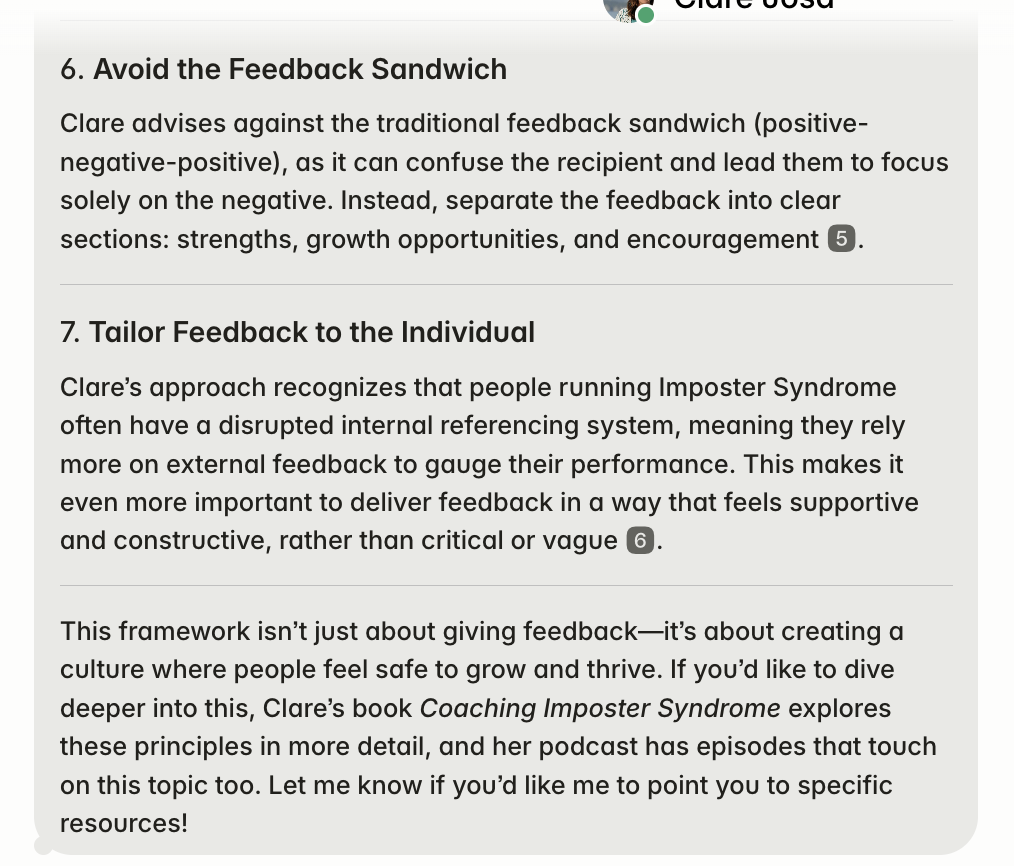
Here are the screenshots of this interaction. The numbers are links to resources and references, for people who want to dive right in and take more action.
![It’s okay not to feel brave right now. Bravery isn’t about feeling fearless—it’s about taking action even when fear is present. And the good news is, you don’t need to leap into bravery all at once. This is where something I call **MicroCourage** comes in. It’s about taking tiny, manageable steps that feel just a little bit outside your comfort zone, rather than overwhelming yourself with big, scary leaps [3][4][29]. Here’s how you can start: 1. **Find Your First MicroAction** – Think of one small thing you could do today that feels just a little bit stretchy but still safe. For example, if you’re holding back from speaking up in a meeting, maybe your MicroAction is to share one idea or ask one question. It doesn’t have to be perfect—it just has to be a step forward [4][29]. 2. **Celebrate Your Wins** – Each time you take a step, no matter how small, celebrate it. This helps rewire your brain to associate courage with positive outcomes. It’s not about the size of the action—it’s about the fact that you did it [4]. 3. **Reframe Fear as a Mind-Story** – Often, the fear we feel isn’t about real danger—it’s what I call a “Mind-Story Fear,” created by the stories we tell ourselves about what might go wrong. Ask yourself: “What’s the story my mind is telling me right now?” Then remind yourself, “It’s just a story—it’s not the truth” [2][3]. 4. **Use the Flinch Factor** – If you notice your body tensing up when you’re about to take a brave step, that’s the Flinch Factor kicking in. It’s your body’s way of saying, “This feels scary.” Take a deep breath, soften your shoulders, and remind yourself that you’re safe. This helps you move through the fear without freezing [29]. Remember, courage isn’t about being fearless—it’s about showing up anyway, one tiny step at a time. And those small steps add up to big changes. If you’d like more support with this, my book *Ditching Imposter Syndrome* has practical exercises to help you build your courage muscle, or you can explore the Sixty-Second Courage Creator training inside the Imposter Syndrome Hacks™ App - https://www.impostersyndromehacks.com. You’ve got this.](https://ditchingimpostersyndrome.com/wp-content/uploads/2025/04/Screenshot-2025-04-25-at-15.14.31.png)
![It’s okay not to feel brave right now. Bravery isn’t about feeling fearless—it’s about taking action even when fear is present. And the good news is, you don’t need to leap into bravery all at once. This is where something I call **MicroCourage** comes in. It’s about taking tiny, manageable steps that feel just a little bit outside your comfort zone, rather than overwhelming yourself with big, scary leaps [3][4][29]. Here’s how you can start: 1. **Find Your First MicroAction** – Think of one small thing you could do today that feels just a little bit stretchy but still safe. For example, if you’re holding back from speaking up in a meeting, maybe your MicroAction is to share one idea or ask one question. It doesn’t have to be perfect—it just has to be a step forward [4][29]. 2. **Celebrate Your Wins** – Each time you take a step, no matter how small, celebrate it. This helps rewire your brain to associate courage with positive outcomes. It’s not about the size of the action—it’s about the fact that you did it [4]. 3. **Reframe Fear as a Mind-Story** – Often, the fear we feel isn’t about real danger—it’s what I call a “Mind-Story Fear,” created by the stories we tell ourselves about what might go wrong. Ask yourself: “What’s the story my mind is telling me right now?” Then remind yourself, “It’s just a story—it’s not the truth” [2][3]. 4. **Use the Flinch Factor** – If you notice your body tensing up when you’re about to take a brave step, that’s the Flinch Factor kicking in. It’s your body’s way of saying, “This feels scary.” Take a deep breath, soften your shoulders, and remind yourself that you’re safe. This helps you move through the fear without freezing [29]. Remember, courage isn’t about being fearless—it’s about showing up anyway, one tiny step at a time. And those small steps add up to big changes. If you’d like more support with this, my book *Ditching Imposter Syndrome* has practical exercises to help you build your courage muscle, or you can explore the Sixty-Second Courage Creator training inside the Imposter Syndrome Hacks™ App - https://www.impostersyndromehacks.com. You’ve got this.](https://ditchingimpostersyndrome.com/wp-content/uploads/2025/04/Screenshot-2025-04-25-at-15.14.41.png)
![It’s okay not to feel brave right now. Bravery isn’t about feeling fearless—it’s about taking action even when fear is present. And the good news is, you don’t need to leap into bravery all at once. This is where something I call **MicroCourage** comes in. It’s about taking tiny, manageable steps that feel just a little bit outside your comfort zone, rather than overwhelming yourself with big, scary leaps [3][4][29]. Here’s how you can start: 1. **Find Your First MicroAction** – Think of one small thing you could do today that feels just a little bit stretchy but still safe. For example, if you’re holding back from speaking up in a meeting, maybe your MicroAction is to share one idea or ask one question. It doesn’t have to be perfect—it just has to be a step forward [4][29]. 2. **Celebrate Your Wins** – Each time you take a step, no matter how small, celebrate it. This helps rewire your brain to associate courage with positive outcomes. It’s not about the size of the action—it’s about the fact that you did it [4]. 3. **Reframe Fear as a Mind-Story** – Often, the fear we feel isn’t about real danger—it’s what I call a “Mind-Story Fear,” created by the stories we tell ourselves about what might go wrong. Ask yourself: “What’s the story my mind is telling me right now?” Then remind yourself, “It’s just a story—it’s not the truth” [2][3]. 4. **Use the Flinch Factor** – If you notice your body tensing up when you’re about to take a brave step, that’s the Flinch Factor kicking in. It’s your body’s way of saying, “This feels scary.” Take a deep breath, soften your shoulders, and remind yourself that you’re safe. This helps you move through the fear without freezing [29]. Remember, courage isn’t about being fearless—it’s about showing up anyway, one tiny step at a time. And those small steps add up to big changes. If you’d like more support with this, my book *Ditching Imposter Syndrome* has practical exercises to help you build your courage muscle, or you can explore the Sixty-Second Courage Creator training inside the Imposter Syndrome Hacks™ App - https://www.impostersyndromehacks.com. You’ve got this.](https://ditchingimpostersyndrome.com/wp-content/uploads/2025/04/Screenshot-2025-04-25-at-15.14.50.png)
How Can I Tell If I'm Making Progress?
Sometimes it's easy to miss the daily shifts that build into bigger breakthroughs. So that's built in with the Ditching Imposter Syndrome Activator™.
Not only does the book have strategies to help with this, but you'll also get to take Clare's research-designed Imposter Syndrome Assessment tool every six months, and you can compare your scores side by side, to see and feel the progress you're making.
It's all included in the Activator programme.
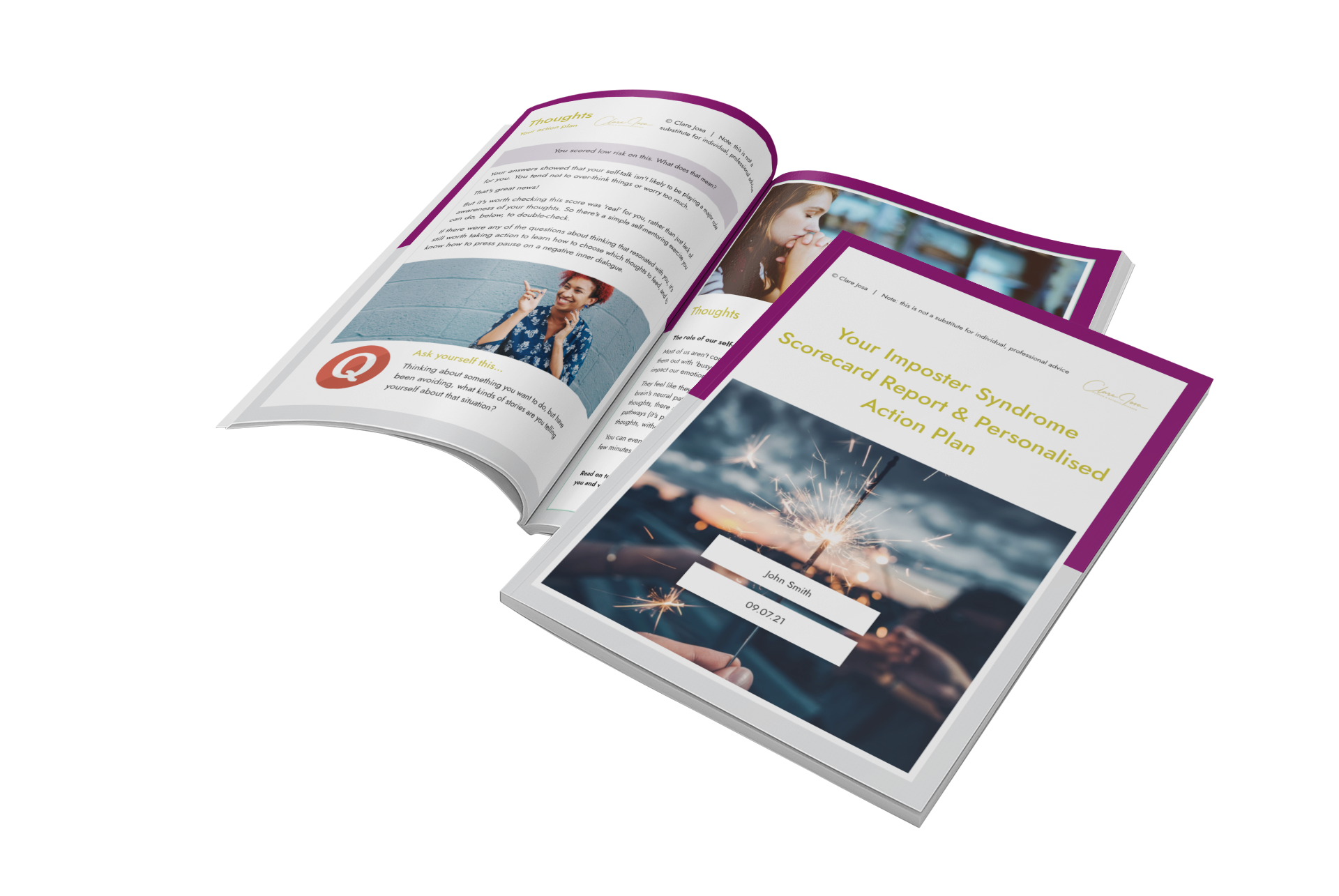

Clare Josa, Global Authority on Imposter Syndrome & Creator of AskClare.ai™
There's only one of me. But now I can be there for you, 24/7.
What happens if you need Imposter Syndrome or confidence help and advice in-the-moment?
If you turn to ChatGPT, you're at the whim of whichever bit of internet myth and fluff its databanks randomly regurgitate.
If you ask Google, you'll be given – at best – coping strategies and 'just reframe it as a good thing', not solutions that actually make a difference.
Wouldn't it be incredible to be able to just send me a message and get instant, personalised feedback and suggestions - strategies that actually work?
That's why we've built AskClare.ai™ for you.
AskClare.ai™ has been trained on my brain, with:
2.7 million of my words & rising
500+ podcast episodes & videos
10 books & 100+ training courses & over 1,000 articles
Proven strategies from thousands of mentoring sessions spanning 20+ years
Here are some more real-world questions people have asked AskClare.ai™ - and how it guided them.
Questions that needed a deeply trauma-informed approach:
Here are the screenshots of this interaction. The numbers are links to resources and references, for people who want to dive right in and take more action.

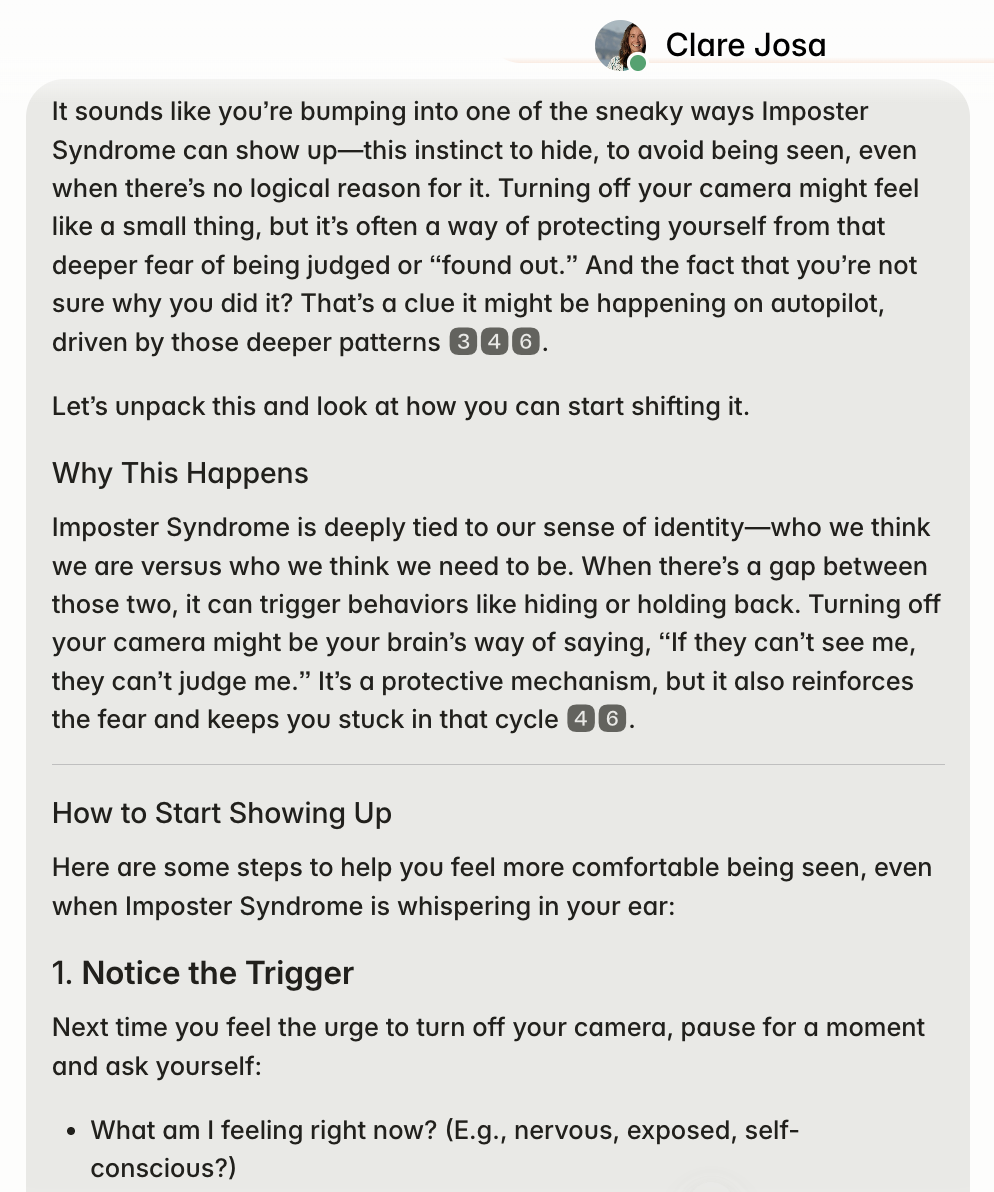
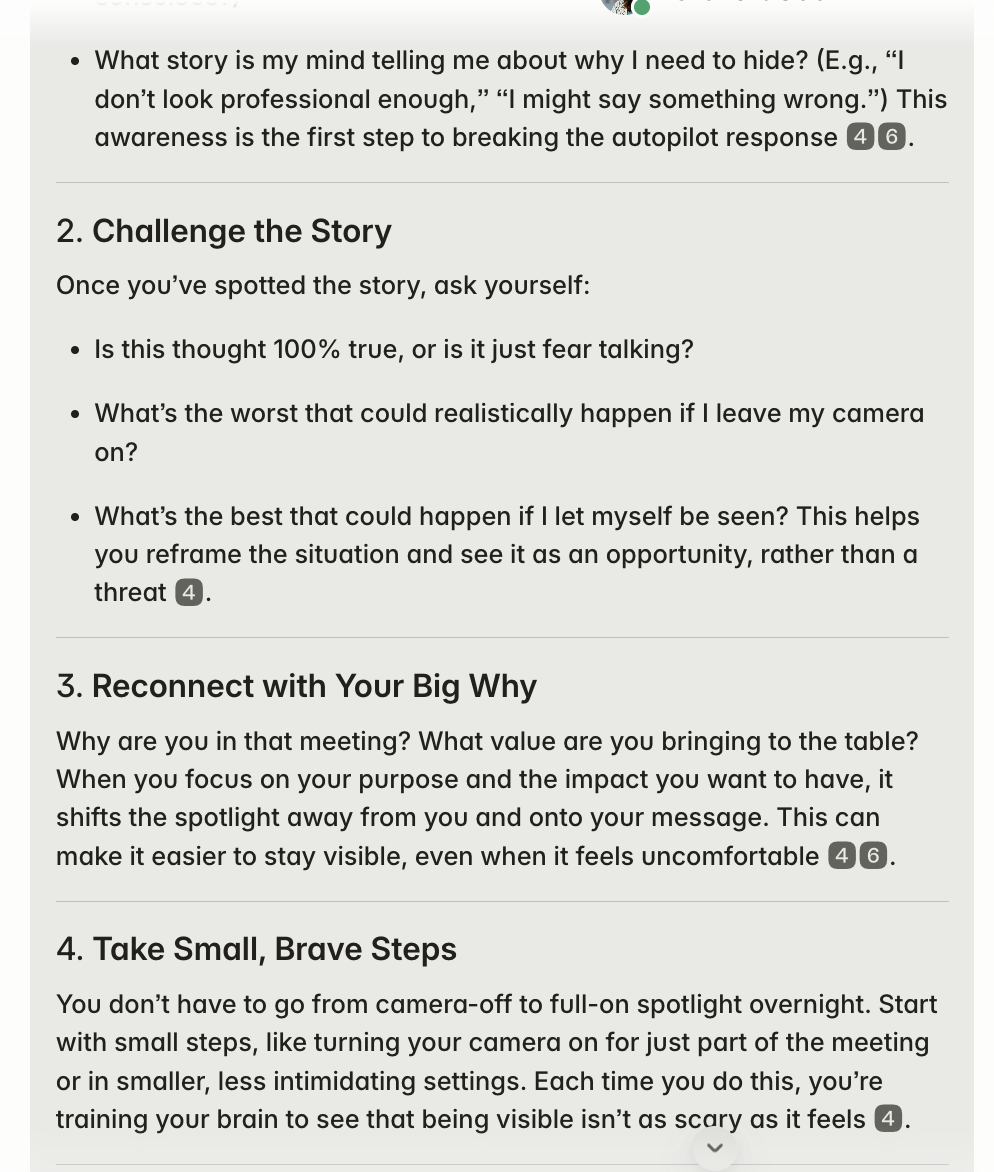
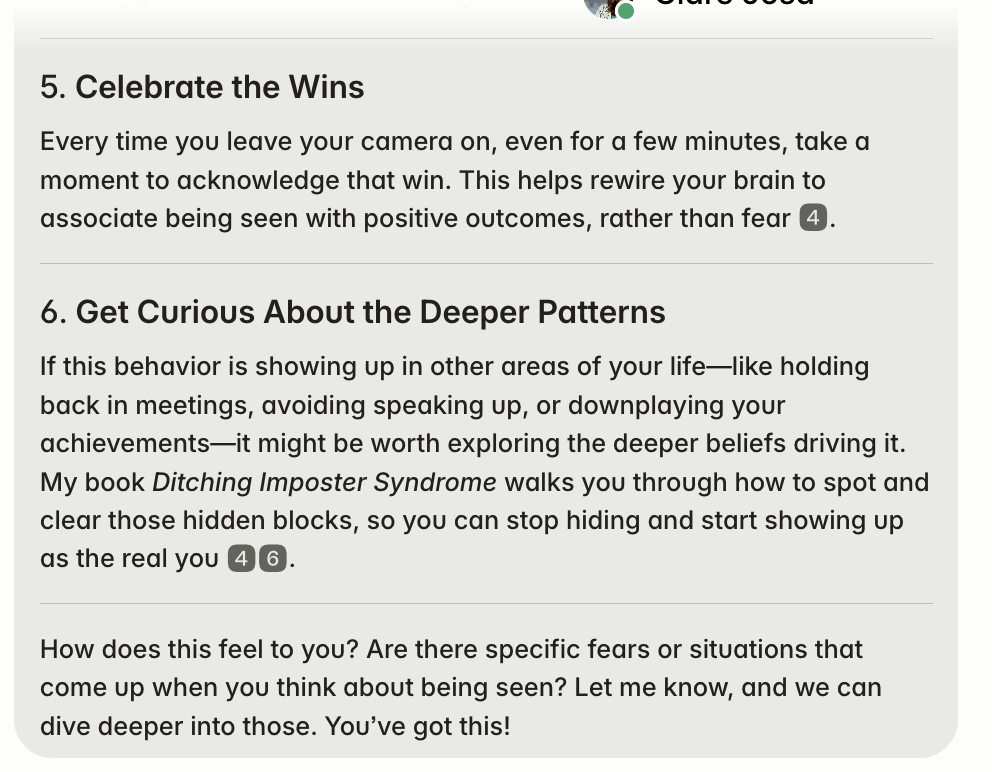
Here are the screenshots of this interaction. The numbers are links to resources and references, for people who want to dive right in and take more action.

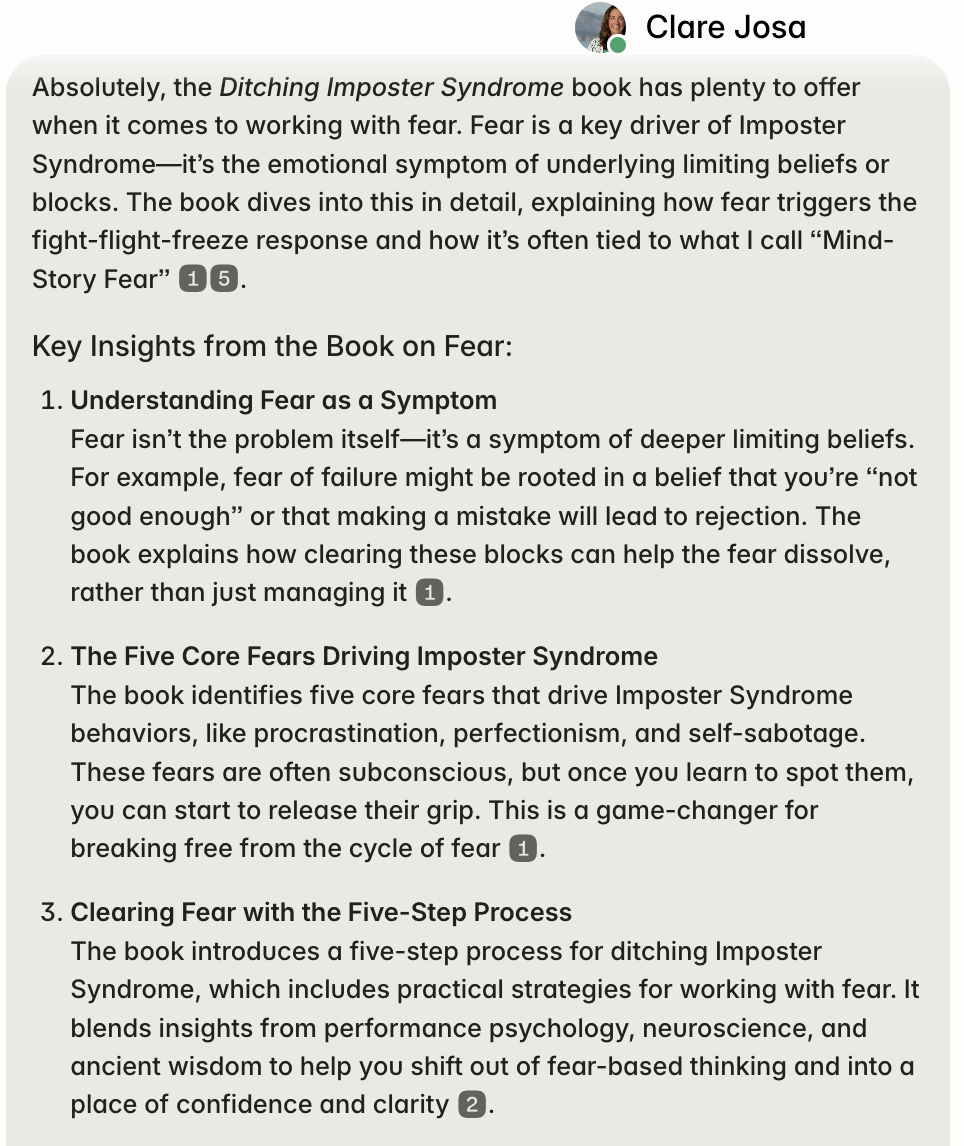
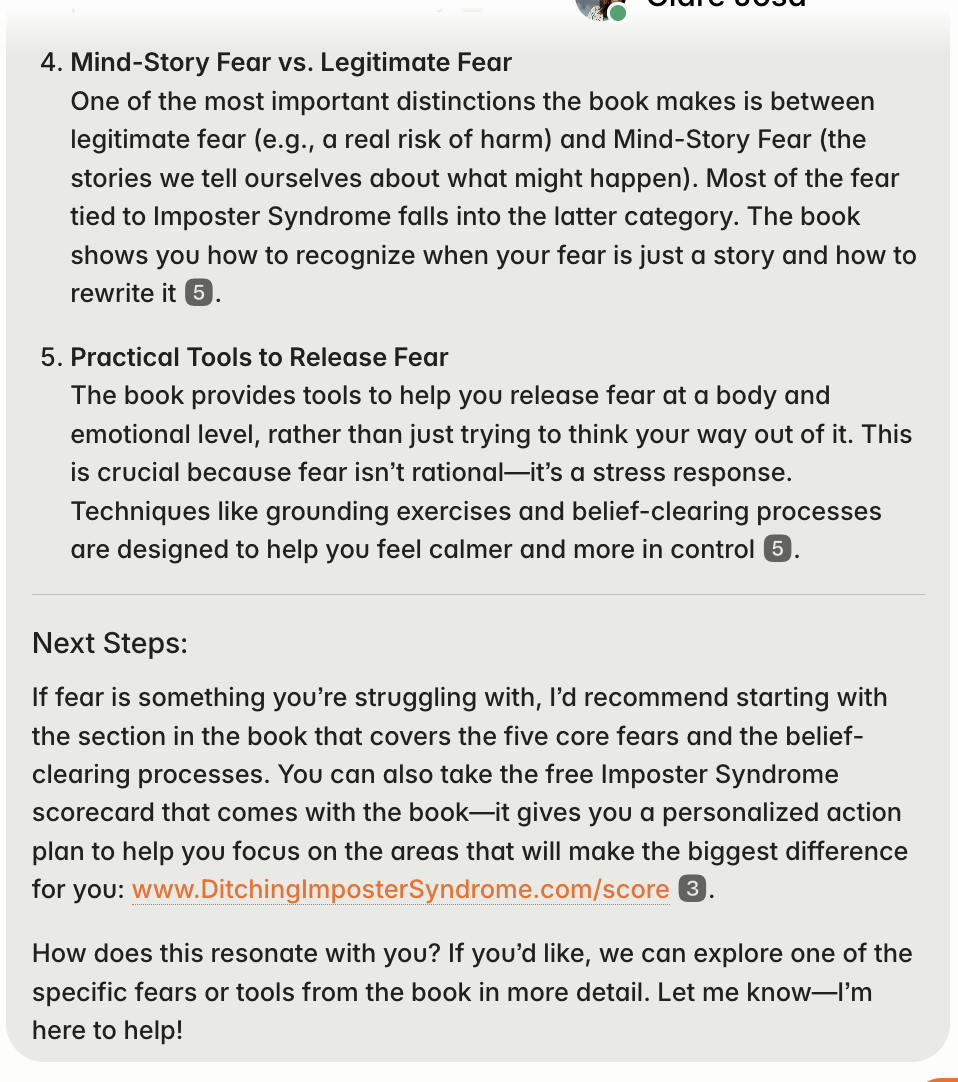
Here are the screenshots of this interaction. The numbers are links to resources and references, for people who want to dive right in and take more action.

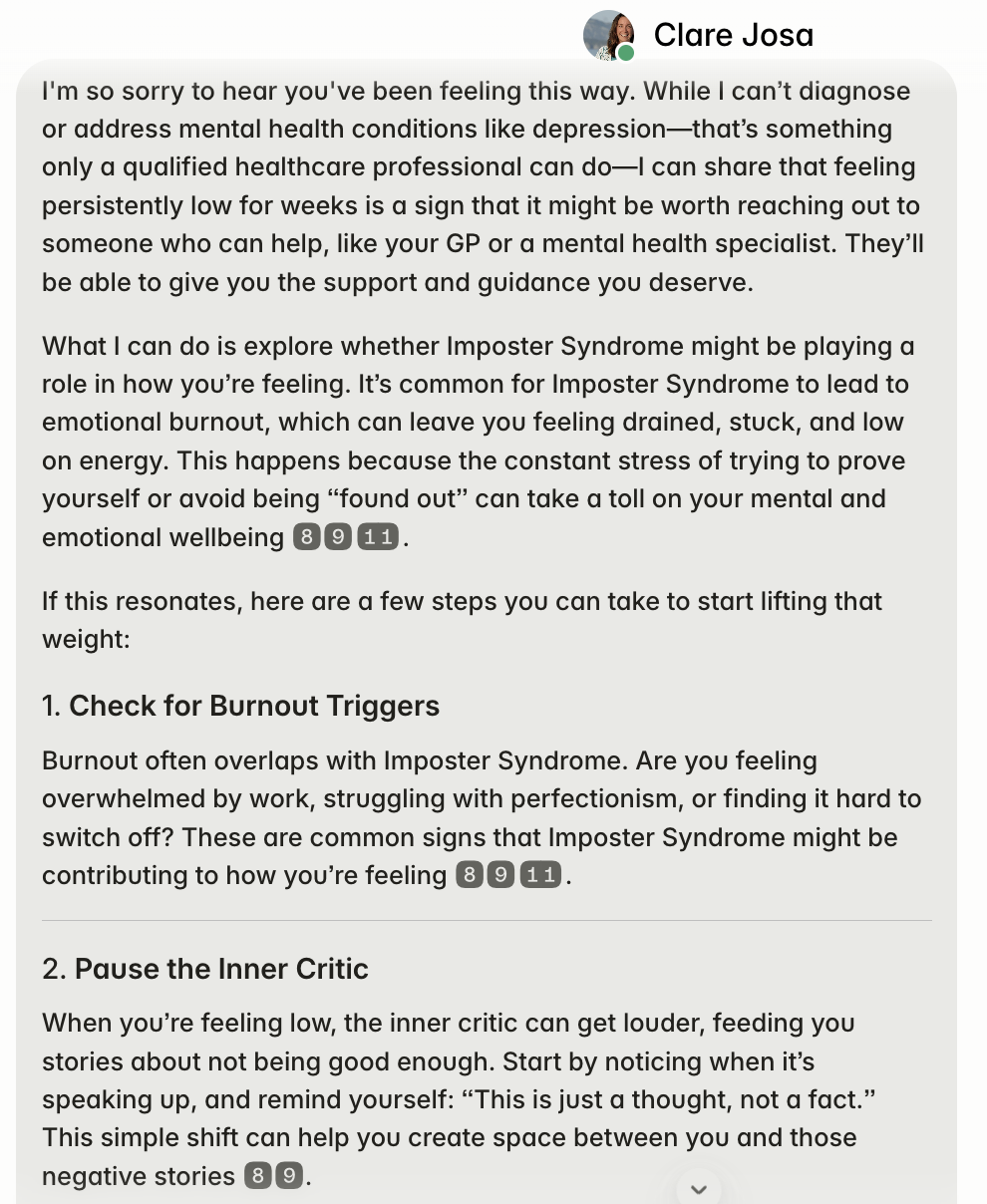
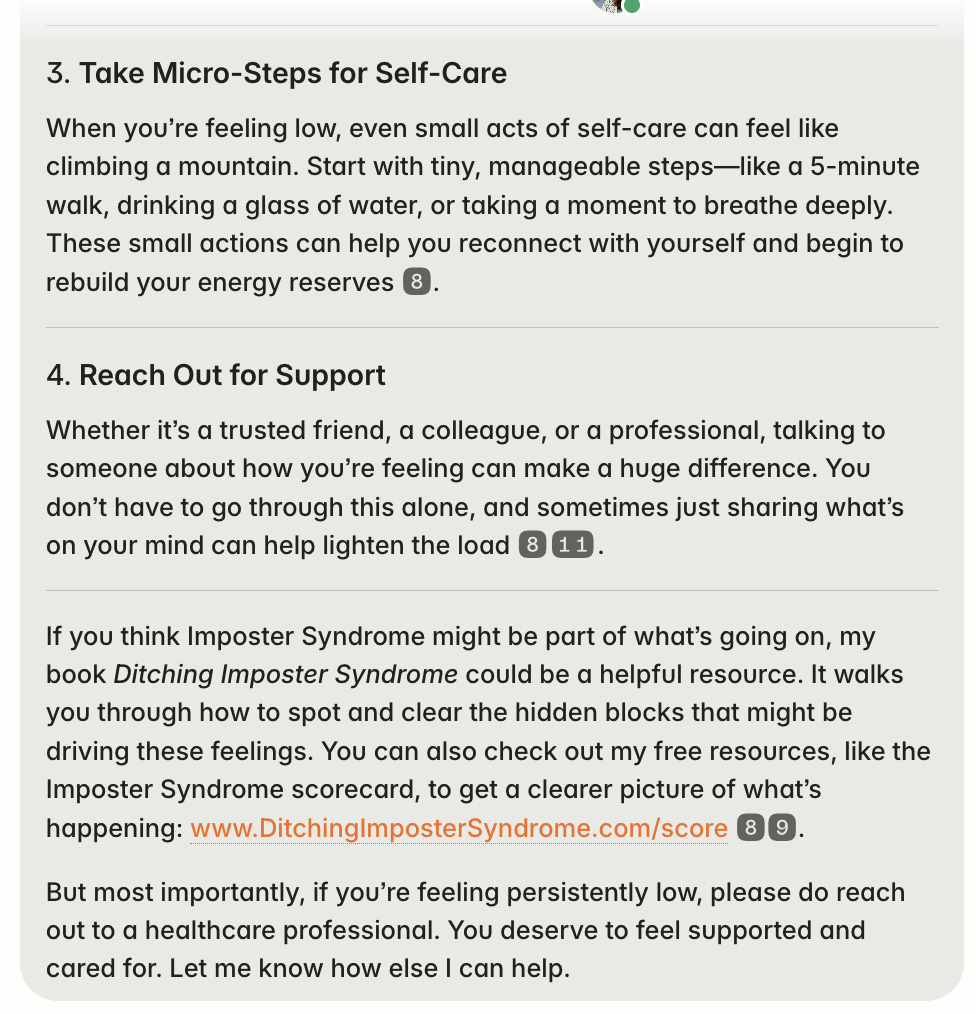
Your Investment
No subscription. No automatic renewal.
We've been running AskClare.ai™ with a closed group of users who have put it through its paces over the past six months, and doors are now open to the public.
During this launch phase, we're offering you a never-to-be-repeated launch price for the first 250 users of just:
£97 (instead of £197) for the Ditching Imposter Syndrome Activator™ and 6 months' access to AskClare.ai™.
Or you can have 12 months' AskClare.ai™ support for just £147 (instead of £297).
That's less than the cost of a 30-minute call with one of Clare's certified Imposter Syndrome Master Coaches.
If you want to extend at the end of your six or twelve months, we'll offer you options.
But it's entirely your choice - you opt in, not opt out. No tie-in.
Get 24/7 personalised support for less than the cost of a 30-minute session with one of Clare's certified Imposter Syndrome Master Coaches.
Try It For Yourself With Our 30-Day Risk-Free Guarantee
There's absolutely NO RISK with our 30-day money back guarantee.
Dive in and make the most of the Ditching Imposter Syndrome Activator™ and if it genuinely doesn't help you, reply to any of the emails we'll have sent you and we'll give you a no-sulk refund.
All we ask is that you have truly tried it on for size - after all, you wouldn't take a banana back to the store because you didn't eat it and it went brown!
FAQs
To make it easy for you to find the answer to your question, we've split these into sections. They are:
How Can I Get The Best Results?
Got a question we haven't covered? Get in touch here.
Your conversations are confidential. Conversations may be reviewed anonymously by Clare for continuous improvement of AskClare.ai's training, but they'll never be shared with any third party.
The system stores your conversations against your email address, so that they stay unique to you. And there's a double-layer of security - even after logging in to the Ditching Imposter Syndrome Activator™ training area, to chat with AskClare.ai™ you'll be asked to enter a security code that it sends to your email address, as a two-factor authentication.
All data is processed in line with our privacy policy.
If your employer has purchased an enterprise licence, the only data they get is anonymised, based on usage, not individual questions. They may opt for a bespoke report on core themes each year, but these would be completely anonymous. AskClare.ai™ is hosted on Clare's secure training vault, not your employer's IT system, so they cannot access the data.
One of the things that Clare is passionate about is making sure her work is trauma-informed - it won't trigger trauma, and it's clear what to do if someone's trauma surfaces. Because AskClare.ai™ is a 'closed system', built on 2.7 million of Clare's words, it's automatically trauma-informed.
If you look at the example question above "I've been feeling really low for weeks. Do you think I might be depressed?" it shows you how AskClare.ai™ is likely to handle this kind of situation.
AskClare.ai™ is hosted inside Clare's secure online training vault. Once you make your payment, you'll be asked to choose a secure password and then you'll be able to log in.
That's also where you'll find the rest of the resources in your Ditching Imposter Syndrome Activator™.
Once your six or twelve months expire, you'll keep access to your other resources, but to access AskClare.ai™ again you'll need to renew.
No. Everything is hosted online. No app to download and continually update... As long as you can access the internet, you'll be able to get the most from AskClare.ai™ and the other resources in your Activator.
Yes. As long as you have a web browser, you can use it.
And your account syncs across all of your devices.
Yes, you do. As soon as you have made your payment, chosen your password, and logged in, it's all there waiting for you.
And we'll send you a laid-back welcome email series to help you to get the most from the Activator.
That's easy. As we said, it's opt IN not opt OUT. There's no tie-in and no sneaky surprises.
A few weeks before your renewal date we'll email you to let you know the current options.
If you want to take up one of them, great. You'll get continued access.
If you don't, that's also fine. We'll keep your data for one calendar month so your conversations are still there if you missed the emails and renew a little late. But after that your AskClare.ai™ account data is deleted.
No. You are making a one-time payment and there is no automatic renewal.
But if you're loving AskClare.ai™ and want to keep going, we make it as easy as possible for you to do that.
You are totally in control of how long you want to have the support from AskClare.ai™.
Yes. Enterprise and team packages are available, and they can also include training team members to coach others in Imposter Syndrome. Here's some more information on bulk licences and how to apply for one in the next release.
Unfortunately not, for a single licence. The admin outweighs the licence cost. However, you will get a VAT receipt when you pay by card, which you can use for your business or employer.
You've got a full 30 days to try the Ditching Imposter Syndrome Activator™ out for yourself, and if it doesn't help you, just email us.
You can send us a new email (you'll have our support contact details) or reply to an email we've sent you.
We won't sulk or strop. We get it - sometimes things are a great fit, but sometimes they're not. And we'd much rather be able to help sort that for you and stay friends than have you feeling hard done by.
All we ask is that you've actually tried the programme and resources on for size.
This guarantee is in addition to your statutory rights under UK law, as a consumer, and this forms parts of our terms and conditions.
As we said earlier - it's not a 'brown banana' guarantee if you choose not to use this at all.
So if you're not sure if you want to dive in with this, then the timing might not be right just now - and you'd be welcome to come back at some point in the future when your need to ditch Imposter Syndrome is greater.
Firstly - yay! That is the wonderful outcome that we want for you.
But no, this isn't a month-by-month commitment.
When students find they have ditched Imposter Syndrome, once and for all, they love to keep going for a while to apply the strategies in other areas of their life, and to clear out other limiting beliefs.
The Activator and AskClare.ai™ don't just help with Imposter Syndrome, they can help with stress, burnout, confidence, self-awareness, and even helping other with this.
AskClare.ai™ is a 'closed system'. This means that, apart from its training in conversational skills, the only information it is allowed to use is from the 2.7 million of Clare's words that were used to train it.
This means that you're not at risk of coaching platitudes telling you to 'be happy' or 'see the positive side of Imposter Syndrome', and you're safe from the dodgy advice and myths that keep people stuck, which crowd the internet.
You're going to be given guidance that is based on 20+ years of studying, researching, testing, proving the strategies work, not guesswork.
We've spent six months testing AskClare.ai™ with real user questions, and Clare and her team have also plugged many of these into ChatGPT and other LLM systems to compare the answers. The results were stark and obvious.
AskClare.ai™ consistently gave suggestions that were actionable and evidence-based, instead of generic, and it significantly out-performed the other models on safety and being trauma-informed and not becoming an 'accidental therapist'.
Coaching with a - suitably trained - human is still the gold standard. It can help you to create the deepest breakthroughs. But it can also be slow, expensive, and your coach is unlikely to be thrilled if you message them during a 3am self-talk confidence wobble and expect them to reply.
AskClare.ai™ fills that gap.
And when combined with Ditching Imposter Syndrome and the other resources you get in your Activator, it gives you a totally customisable, fully supported journey.
Absolutely. There's a world of difference between reading a book and implementing what it's sharing with you.
The Ditching Imposter Syndrome Activator™ is specially designed to help to bridge that gap.
Inspiration is great. But it's implementation - forming the habit - that creates change.
Definitely. We give you the eBook and audiobook versions of Ditching Imposter Syndrome to support your journey. So dive in today and start cranking up your confidence, shrinking your stress levels, and waving goodbye to Imposter Syndrome, even before you go to bed tonight.
Coaching and therapy are two very different things. And if any coach tells you they're not, or tries to use tools with you from the world of psychotherapy, please reconsider working with them.
AskClare.ai™ is not intended to replace formal therapy or counselling for those in need.
But it is trauma-informed, and it knows its limits.
And there's a link right below your AskClare.ai™ interface to let you know how you can get deeper support, if you need it.
That's entirely up to you. The most important thing is to be choosing daily habits from the Ditching Imposter Syndrome book and experimenting with those several times a day. It only takes a few minutes.
Some people complete everything from the book in a few weeks. Others take longer. It's your journey, and there's no pressure or judgement.
You can get a full year's access to AskClare.ai™ and no-expiry access to the rest of the resources in the Ditching Imposter Syndrome Activator™ for less than the cost of a 30-minute coaching call with one of Clare's certified Imposter Syndrome Master Coaches.
And AskClare.ai™ is so well trained that - and Clare publicly admits this - it often gives better answers than she would have done! After all, it can near-instantly turn to 20 years of insights and give you what you most need in seconds - something that might take Clare an hour or more to think through and weigh options.
So if you use the Activator resources, including AskClare.ai™, for more than half an hour in a year, you've already recouped your investment.
If, realistically, you don't feel you can commit more than half an hour a year for ditching Imposter Syndrome and boosting your confidence, then this probably isn't the right resource for you.
Firstly, the Ditching Imposter Syndrome book is designed to help you to spot the shifts you're making, as you go through it. And there are specially designed strategies to help make these clearer to you - and to celebrate them.
You'll also get to take Clare's research-designed Imposter Syndrome Assessment Tool every six months, and you can compare your responses in your training vault. So you won't just feel the progress, you'll be able to measure it with data, too.
Copyright Soultuitive Leadership Ltd 2025, all rights reserve | Privacy Policy | Ts & Cs | Contact Us